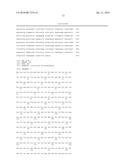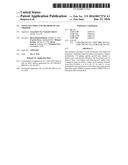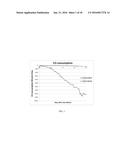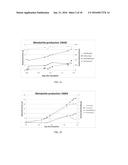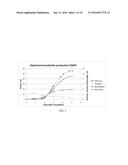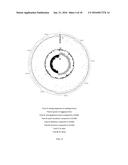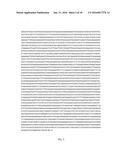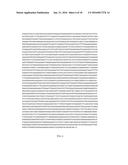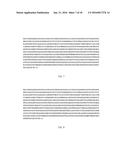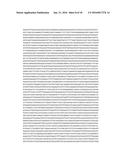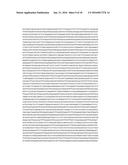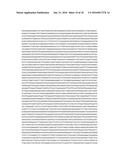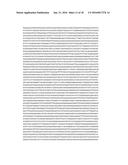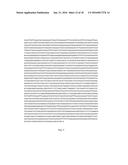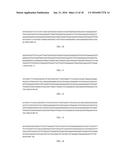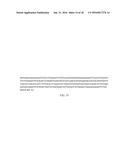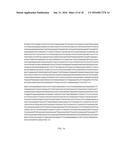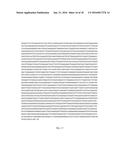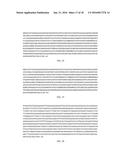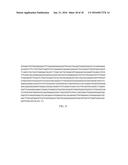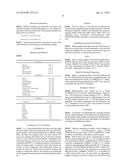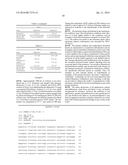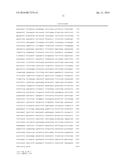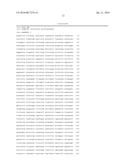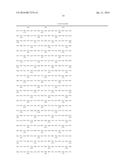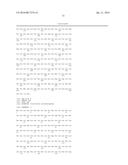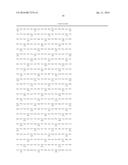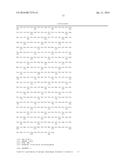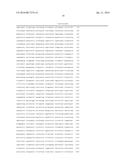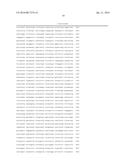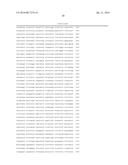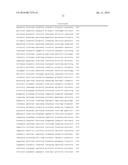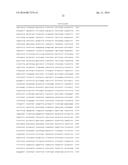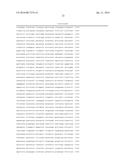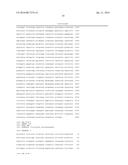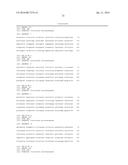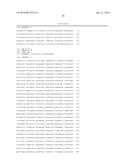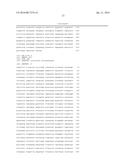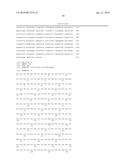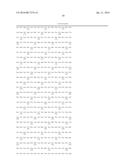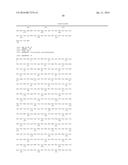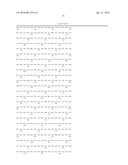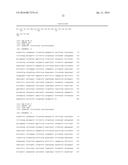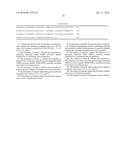Patent application title: NOVEL BACTERIA AND METHODS OF USE THEREOF
Inventors:
IPC8 Class: AC12N120FI
USPC Class:
435147
Class name: Micro-organism, tissue cell culture or enzyme using process to synthesize a desired chemical compound or composition preparing oxygen-containing organic compound containing carbonyl group
Publication date: 2016-01-21
Patent application number: 20160017276
Abstract:
The invention provides a novel bacterium with improved properties,
including improved ethanol production, ethanol productivity, CO uptake,
specific growth rate, ethanol to acetate ratio, and alcohol tolerance.
The bacterium may be derived from Clostridium autoethanogenum and/or may
comprise at least one DNA or amino acid sequence selected from SEQ ID
NOs: 1, 3, 6, 8, 10, 12, 14, and 16. In one embodiment, the bacterium is
Clostridium autoethanogenum deposited under DSMZ accession number
DSM23693 or a bacterium derived therefrom.Claims:
1. A bacterium derived from Clostridium autoethanogenum wherein the
bacterium comprises least one DNA or amino acid sequence selected from
SEQ ID NOs: 1, 3, 6, 8, 10, 12, 14, and 16.
2. The bacterium of claim 1, wherein the bacterium is a bacterium deposited under DSMZ accession number DSM23693 or a bacterium derived therefrom.
3. The bacterium of claim 1, wherein the bacterium is derived from Clostridium autoethanogenum deposited under DSMZ accession number DSM19630 or naturally occurring Clostridium autoethanogenum.
4. The bacterium of claim 1, wherein the bacterium ferments a gaseous substrate to produce one or more products.
5. The bacterium of claim 4, wherein the gaseous substrate comprises one or more of CO, CO2, and H.sub.2.
6. The bacterium of claim 4, wherein the products comprise one or more of alcohol and acetate.
7. The bacterium of claim 6, wherein the alcohol is ethanol.
8. A method of producing a product comprising culturing the bacterium of claim 1 in the presence of a gaseous substrate whereby the bacterium produces one or more products.
9. The method of claim 8, wherein the bacterium is a bacterium deposited under DSMZ accession number DSM23693 or a bacterium derived therefrom.
10. The method of claim 8, wherein the bacterium is derived from Clostridium autoethanogenum deposited under DSMZ accession number DSM19630 or naturally occurring Clostridium autoethanogenum.
11. The method of claim 8, wherein the gaseous substrate comprises one or more of CO, CO2, and H.sub.2.
12. The method of claim 8, wherein the products comprise one or more of alcohol and acetate.
13. The method of claim 12, wherein the alcohol is ethanol.
Description:
CROSS REFERENCE TO RELATED APPLICATIONS
[0001] This application is a continuation of U.S. patent application Ser. No. 13/812,029 filed Jan. 24, 2013, which is a national stage of International Patent Application PCT/NZ2011/000144 filed Jul. 28, 2011, which is a nonprovisional of U.S. Patent Application 61/368,486 filed Jul. 28, 2010, the entirety of which are incorporated herein by reference.
FIELD OF THE INVENTION
[0002] This invention relates generally to the field of microbial fermentation of gases. It more particularly relates to a novel class of bacteria with improved efficiency in the production of ethanol by anaerobic fermentation of substrates containing carbon monoxide (CO).
BACKGROUND OF THE INVENTION
[0003] Ethanol is rapidly becoming a major hydrogen-rich liquid transport fuel around the world. Worldwide consumption of ethanol in 2005 was an estimated 12.2 billion gallons. The global market for the fuel ethanol industry has also been predicted to grow sharply in future, due to an increased interest in ethanol in Europe, Japan, the USA, and several developing nations.
[0004] For example, in the USA, ethanol is used to produce E10, a 10% mixture of ethanol in gasoline. In E10 blends the ethanol component acts as an oxygenating agent, improving the efficiency of combustion and reducing the production of air pollutants. In Brazil, ethanol satisfies approximately 30% of the transport fuel demand, as both an oxygenating agent blended in gasoline, and as a pure fuel in its own right. Also, in Europe, environmental concerns surrounding the consequences of Green House Gas (GHG) emissions have been the stimulus for the European Union (EU) to set member nations a mandated target for the consumption of sustainable transport fuels such as biomass derived ethanol.
[0005] The vast majority of fuel ethanol is produced via traditional yeast-based fermentation processes that use crop derived carbohydrates, such as sucrose extracted from sugarcane or starch extracted from grain crops, as the main carbon source. However, the cost of these carbohydrate feed stocks is influenced by their value as human food or animal feed, while the cultivation of starch or sucrose-producing crops for ethanol production is not economically sustainable in all geographies. Therefore, it is of interest to develop technologies to convert lower cost and/or more abundant carbon resources into fuel ethanol.
[0006] CO is a major, free, energy-rich by-product of the incomplete combustion of organic materials such as coal or oil and oil derived products. For example, the steel industry in Australia is reported to produce and release into the atmosphere over 500,000 tonnes of CO annually.
[0007] Catalytic processes may be used to convert gases consisting primarily of CO and/or CO and hydrogen (H2) into a variety of fuels and chemicals. Micro-organisms may also be used to convert these gases into fuels and chemicals.
[0008] The ability of micro-organisms to grow on CO as a sole carbon source was first discovered in 1903. This was later determined to be a property of organisms that use the acetyl coenzyme A (acetyl CoA) biochemical pathway of autotrophic growth (also known as the Woods-Ljungdahl pathway and the carbon monoxide dehydrogenase acetyl CoA synthase (CODH/ACS) pathway). A large number of anaerobic organisms including carboxydotrophic, photosynthetic, methanogenic and acetogenic organisms have been shown to metabolize CO to various end products, namely CO2, H2, methane, n-butanol, acetate and ethanol. While using CO as the sole carbon source, all such organisms produce at least two of these end products.
[0009] Anaerobic bacteria, such as those from the genus Clostridium, have been demonstrated to produce ethanol from CO, CO2 and H2 via the acetyl CoA biochemical pathway. For example, various strains of Clostridium ljungdahlii that produce ethanol from gases are described in WO 00/68407, EP 117309, U.S. Pat. Nos. 5,173,429, 5,593,886, and 6,368,819, WO 98/00558 and WO 02/08438. The bacterium Clostridium autoethanogenum sp is also known to produce ethanol from gases (Abrini et al., Archives of Microbiology 161, pp 345-351 (1994)).
[0010] However, ethanol production by micro-organisms by fermentation of gases is always associated with co-production of acetate and/or acetic acid. As some of the available carbon is converted into acetate/acetic acid rather than ethanol, the efficiency of production of ethanol using such fermentation processes may be less than desirable. Also, unless the acetate/acetic acid by-product can be used for some other purpose, it may pose a waste disposal problem. Acetate/acetic acid is converted to methane by micro-organisms and therefore has the potential to contribute to GHG emissions.
[0011] 0011 Microbial fermentation of CO in the presence of H2 can lead to substantially complete carbon transfer into an alcohol. However, in the absence of sufficient H2, some of the CO is converted into alcohol, while a significant portion is converted to CO2 as shown in the following equations:
6CO+3H2O→C2H5OH+4CO2
12H2+4CO2→2C2H5OH+6H2O
[0012] The production of CO2 represents inefficiency in overall carbon capture and if released, also has the potential to contribute to Green House Gas emissions.
[0013] WO2007/117157 describes a process that produces alcohols, particularly ethanol, by anaerobic fermentation of gases containing carbon monoxide. Acetate produced as a by-product of the fermentation process is converted into hydrogen gas and carbon dioxide gas, either or both of which may be used in the anaerobic fermentation process.
[0014] WO2008/115080 describes a process for the production of alcohol(s) in multiple fermentation stages. By-products produced as a result of anaerobic fermentation of gas(es) in a first bioreactor can be used to produce products in a second bioreactor. Furthermore, by-products of the second fermentation stage can be recycled to the first bioreactor to produce products.
[0015] WO2009/064200 describes a novel class of bacteria which has improved efficiency in the production of ethanol by anaerobic fermentation of substrates containing carbon monoxide.
[0016] It would be beneficial to provide micro-organisms that are capable of fermentation of gases containing carbon monoxide to ethanol at increased efficiency, that is micro-organisms capable of improved uptake of carbon monoxide, of producing more ethanol, and/or a greater ratio of ethanol to acetate from the same substrate, than do micro-organisms of the prior art.
[0017] It is an object of the present invention to provide a new class of bacteria which overcomes one or more of the limitations of the prior art in the conversion of gaseous sources containing CO into ethanol, or to at least provide the public with a useful choice.
SUMMARY OF THE INVENTION
[0018] In a first aspect the invention provides a biologically pure isolate of a bacterium wherein the bacterium is capable of producing products including ethanol and optionally acetate, by anaerobic fermentation of a substrate comprising CO, at a specific productivity of at least about 2 g ethanol/L fermentation broth/gram of biomass/day.
[0019] In other embodiments, the bacterium is capable of producing ethanol at a specific productivity of at least about 3 g ethanol/L fermentation broth/gram of biomass/day, at least about 4 g ethanol/L fermentation broth/gram of biomass/day, at least about 5 g ethanol/L fermentation broth/gram of biomass/day, at least about 6 g ethanol/L fermentation broth/gram of biomass/day or at least about 7 g ethanol/L fermentation broth/gram of biomass/day.
[0020] In another aspect the invention provides a biologically pure isolate of a bacterium wherein the bacterium is capable of producing products including ethanol and optionally acetate, by anaerobic fermentation of a substrate comprising CO, at a productivity of at least about 10 g ethanol/L of fermentation broth/day.
[0021] In other embodiments, the bacterium is capable of producing ethanol at a productivity of at least about 20 g ethanol/L of fermentation broth/day, at least about 30 g ethanol/L of fermentation broth/day, at least about 40 g ethanol/L of fermentation broth/day or at least about 50 g ethanol/L of fermentation broth/day, or at least about 60 g ethanol/L of fermentation broth/day, or at least about 70 g ethanol/L of fermentation broth/day.
[0022] In another aspect the invention provides a biologically pure isolate of a bacterium wherein the bacterium is capable of producing products including ethanol and optionally acetate, by anaerobic fermentation of a substrate comprising CO, and wherein the bacterium is capable of a specific uptake of CO of at least about 1.0 mMol CO/min/g of biomass.
[0023] In one embodiment the bacterium is capable of a specific uptake of CO of at least about 1.2 mMol CO/min/g biomass, at least about 1.4 mMol CO/min/g of biomass, at least about 1.6 mMol CO/min/g of biomass, at least about 1.8 mMol CO/min/g of biomass, or at least about 2.0 mMol CO/min/g of biomass. In one particular embodiment, the bacterium is capable of a specific uptake of CO of at least about 1.2 mMol CO/min/g biomass.
[0024] In another aspect the invention provides a biologically pure isolate of a bacterium wherein the bacterium is capable of producing products including ethanol and optionally acetate, by anaerobic fermentation of a substrate comprising CO, and wherein the bacterium is capable of a specific growth rate of at least about 0.8 day-1.
[0025] In certain embodiments the bacterium is capable of a specific growth rate of at least about 1.0 day-1, at least about 1.2 day-1, at least about 1.4 day-1, at least about 1.6 day-1, at least about 1.8 day-1 or at least about 2.0 day-1.
[0026] In another aspect the invention provides a biologically pure isolate of a bacterium wherein the bacterium is capable of producing products including ethanol and optionally acetate, by anaerobic fermentation of a substrate comprising CO, and wherein the bacterium is capable of producing ethanol at an ethanol to acetate ratio of at least about 2:1.
[0027] In certain embodiments the bacterium is capable of producing ethanol at an ethanol to acetate ratio of at least about 3:1, of at least about 4:1, of at least about 5:1, of at least about 7:1 or of at least about 10:1.
[0028] In one embodiment, the bacterium is capable of producing ethanol with substantially no acetate.
[0029] In another aspect the invention provides a biologically pure isolate of a bacterium wherein the bacterium is capable of producing products including ethanol and optionally acetate, by anaerobic fermentation of a substrate comprising CO, and wherein the bacterium is capable of tolerating alcohol of up to about 30 g/L of fermentation broth.
[0030] In certain embodiment the bacterium is capable of tolerating alcohol of up to about 40 g/L of fermentation broth, of up to about 50 g/L of fermentation broth, of up to about 60 g/L of fermentation broth, or of up to about 70 g/L of fermentation broth.
[0031] In another aspect the invention provides a biologically pure isolate of a bacterium wherein the bacterium is capable of producing products including ethanol and optionally acetate, by anaerobic fermentation of a substrate comprising CO, and wherein the bacterium has two or more of the following characteristics:
[0032] is capable of producing products including ethanol and optionally acetate, by anaerobic fermentation of a substrate comprising CO, at a specific productivity of at least about 2 g of ethanol/L of fermentation broth/gram of biomass/day;
[0033] is capable of producing ethanol at a concentration of at least about 10 g ethanol/L of fermentation broth/day;
[0034] is capable of a specific uptake of CO of at least about 1.0 mMol CO/min/g of biomass;
[0035] is capable of a growth rate of at least about 1.0 g/day;
[0036] is capable of producing ethanol at an ethanol to acetate ratio of at least about 2:1; and, is capable of tolerating alcohol of up to about 30 g/L of broth.
[0037] In one embodiment, the bacteria of the invention are derived from Clostridium autoethanogenum. In a preferred embodiment, the bacterium of the invention is a strain of Clostridium autoethanogenum.
[0038] In a particular embodiment the bacterium has the defining characteristics of the Clostridium autoethanogenum strain deposited at DSMZ under the accession number DMS23693. In one embodiment the bacterium is the Clostridium autoethanogenum strain deposited at DSMZ under the accession number DMS23693.
[0039] In a further aspect the invention provides a biologically pure isolate of the Clostridium autoethanogenum strain deposited at DSMZ under the accession number DMS23693
[0040] In another aspect, the invention provides a method for the production of one or more alcohols comprising fermenting a substrate comprising CO using a bacterium as herein before described.
[0041] In one embodiment the method comprises the steps of:
[0042] (a) providing a substrate comprising CO to a bioreactor containing a culture of a bacterium of the invention; and
[0043] (b) anaerobically fermenting the culture in the bioreactor to produce one or more alcohols.
[0044] In a further aspect, the invention provides a method for reducing the total atmospheric carbon emissions from an industrial process, the method comprising:
[0045] (a) capturing CO-containing gas produced as a result of the industrial process, before the gas is released into the atmosphere;
[0046] (b) the anaerobic fermentation of the CO-containing gas to produce one or more alcohols by a culture containing one or more bacterium of the invention.
[0047] In one embodiment of the method aspects, the fermentation is conducted at a temperature of about 34° C. to about 37° C. In one preferred embodiment, the fermentation is conducted at a temperature of about 34° C.
[0048] In certain embodiments of the method aspects, acetate is produced as a by-product of the fermentation. Preferably the one or more alcohols produced includes ethanol.
[0049] In particular embodiments of the method aspects, the bacterium is maintained in an aqueous culture medium.
[0050] In particular embodiments of the method aspects, the fermentation of the substrate takes place in a bioreactor.
[0051] In certain embodiments the substrate comprises at least about 25% CO by volume, at least about 30% CO by volume, at least about 40% CO by volume, at least about 50% CO by volume, at least about 65% CO by volume or at least about 70% CO by volume. In particular embodiments the substrate comprises at least about 75% CO by volume, at least about 80% CO by volume, at least about 85% CO by volume, at least about 90% CO by volume or at least about 95% CO by volume.
[0052] In one embodiment the substrate comprises about 30% or less H2 by volume. In another embodiments, the substrate comprises about 20% or less H2 by volume, about 15% or less H2 by volume, about 10% or less H2 by volume, about 5% or less H2 by volume, about 4% or less H2 by volume, about 3% or less H2 by volume, about 2% or less H2 by volume, about 1% or less H2 by volume, or substantially no H2.
[0053] In one embodiment the substrate comprises less than or equal to about 20% CO2 by volume. In particular embodiments the substrate comprises less than or equal to about 15% CO2 by volume, less than or equal to about 10% CO2 by volume, less than or equal to about 5% CO2 by volume or substantially no CO2.
[0054] In certain embodiments the substrate comprising CO is a gaseous substrate containing CO.
[0055] In certain embodiments, the gaseous substrate comprises a gas obtained as a by-product of an industrial process.
[0056] In certain embodiments, the industrial process is selected from the group consisting of ferrous metal products manufacturing, non-ferrous products manufacturing, petroleum refining processes, gasification of biomass, gasification of coal, electric power production, carbon black production, ammonia production, methanol production and coke manufacturing.
[0057] In one embodiment, the gaseous substrate may comprise a gas obtained from a steel mill.
[0058] In another embodiment, the gaseous substrate may comprise automobile exhaust fumes.
[0059] In certain embodiments of the method aspects the alcohol is recovered from the fermentation broth, the fermentation broth being the aqueous culture medium comprising bacterial cells and the alcohol.
[0060] In certain embodiments acetate is produced as a by-product of the fermentation.
[0061] In a further embodiment the alcohol and the acetate are recovered from the broth.
[0062] Although the invention is broadly as defined above, it is not limited thereto and also includes embodiments of which the following description provides examples.
BRIEF DESCRIPTION OF THE DRAWINGS
[0063] The invention will now be described in detail with reference to the accompanying Figures in which:
[0064] FIG. 1: Shows the CO consumption of DSM19630 and DSM23693
[0065] FIG. 2a: Shows the metabolite production of DSM19630; FIG. 2b: Shows the metabolite production of DSM23693
[0066] FIG. 3: Shows the optimised biomass accumulation and metabolite production of DSM23693 as described in Example 2.
[0067] FIG. 4: Shows a genetic map of new C. autoethanogenum strain LZ1561 (DSM23693) showing the variations to strain LZ1560 (DSM19630)
[0068] FIG. 5: SEQ ID NO: 1: Nucleotide sequence of DNA mismatch repair protein MutS gene in strain LZ1561
[0069] FIG. 6: SEQ ID NO: 2: Nucleotide sequence of DNA mismatch repair protein MutS gene in strain LZ1560
[0070] FIG. 7: SEQ ID NO: 3: Amino Acid sequence of DNA mismatch repair protein MutS gene in strain LZ1561
[0071] FIG. 8: SEQ ID NO: 4: Amino Acid sequence of DNA mismatch repair protein MutS gene in strain LZ1560
[0072] FIG. 9: SEQ ID NO: 5: Nucleotide sequence found to be re-arranged in strains LZ561 and LZ1560
[0073] FIG. 10: SEQ ID NO: 6: Nucleotide sequence of putative promoter region of F1FO ATP synthase operon in strain LZ1561
[0074] FIG. 11: SEQ ID NO: 7: Nucleotide sequence of putative promoter region of F1FO ATP synthase operon in strain LZ1560
[0075] FIG. 12: SEQ ID NO: 8: Nucleotide sequence of putative promoter region of Rnf complex operon in strain LZ1561
[0076] FIG. 13: SEQ ID NO: 9: Nucleotide sequence of putative promoter region of Rnf complex operon in strain LZ1560
[0077] FIG. 14: SEQ ID NO: 10: Nucleotide sequence of putative promoter region of carbon starvation protein in strain LZ1561
[0078] FIG. 15: SEQ ID NO: 11: Nucleotide sequence of putative promoter region of carbon starvation protein in strain LZ1560
[0079] FIG. 16: SEQ ID NO: 12: Nucleotide sequence of CO dehydrogenase/CO-methylating acetyl-CoA synthase complex beta subunit gene in strain LZ1561
[0080] FIG. 17: SEQ ID NO: 13: Nucleotide sequence of CO dehydrogenase/CO-methylating acetyl-CoA synthase complex beta subunit gene in strain LZ1560
[0081] FIG. 18: SEQ ID NO: 14: Amino Acid sequence of CO dehydrogenase/CO-methylating acetyl-CoA synthase complex beta subunit gene in strain LZ1561
[0082] FIG. 19: SEQ ID NO: 15: Amino Acid sequence of CO dehydrogenase/CO-methylating acetyl-CoA synthase complex beta subunit gene in strain LZ1560
[0083] FIG. 20: SEQ ID NO: 16: Nucleotide sequence of 5,10-methylenetetrahydrofolate reductase gene in strain LZ1561
[0084] FIG. 21: SEQ ID NO: 17: Nucleotide sequence of 5,10-methylenetetrahydrofolate reductase gene in strain LZ1560
DETAILED DESCRIPTION OF THE INVENTION
[0085] The inventors have developed novel bacteria. The bacteria are characterised by having one or more of a number of unexpected properties (as outlined herein after), and in one preferred embodiment all of these properties. The use of these novel bacteria in anaerobic fermentation processes provides an unexpected benefit over existing strains of bacteria which may allow for an increase in the overall efficiency of a fermentation process for producing products such as ethanol and/or acetate.
[0086] Accordingly, in broad terms, in one aspect, the present invention relates to a novel bacterium and a biologically pure isolate of a bacterium with increased efficiency in an anaerobic fermentation process. In one aspect the bacterium is capable of producing an alcohol, preferably ethanol, from a substrate comprising CO.
[0087] In a further aspect, the invention relates to processes for producing an alcohol, preferably ethanol, by anaerobic fermentation of a CO-containing substrate by the bacteria of the invention.
Definitions
[0088] Unless otherwise defined, the following terms as used throughout this specification are defined as follows:
[0089] A "substrate containing CO", a "substrate comprising CO" and like terms should be understood to include any substrate in which carbon monoxide is available to bacteria for growth and/or fermentation, for example. In particular embodiments of the invention the "substrate containing CO" is gaseous. Such substrates may be referred to herein as "gaseous substrates containing CO", "gaseous substrates comprising CO" and the like.
[0090] In the description which follows, embodiments of the invention are described in terms of delivering and fermenting a "gaseous substrate containing CO". However, it should be appreciated that the gaseous substrate may be provided in alternative forms. For example, the gaseous substrate containing CO may be provided dissolved in a liquid. Essentially, a liquid is saturated with a carbon monoxide containing gas and then that liquid is added to the bioreactor. This may be achieved using standard methodology. By way of example, a microbubble dispersion generator (Hensirisak et. al. Scale-up of microbubble dispersion generator for aerobic fermentation; Applied Biochemistry and Biotechnology Volume 101, Number 3/October, 2002) could be used. By way of further example, the gaseous substrate containing CO may be adsorbed onto a solid support. Such alternative methods are encompassed by use of the term "substrate containing CO".
[0091] The terms "increasing the efficiency", "increased efficiency" and the like, when used in relation to a fermentation process, include, but are not limited to, increasing one or more of: the rate of growth of micro-organisms catalysing the fermentation, the uptake or consumption of CO by the micro-organisms, the volume of desired product (such as alcohols) produced per volume of substrate (such as CO) consumed, the concentration of the desired product (such as alcohols) produced in the culture medium, the rate of production or level of production of the desired product, and the relative proportion of the desired product produced compared with other by-products of the fermentation.
[0092] The term "acetate" includes both acetate salt alone and a mixture of molecular or free acetic acid and acetate salt, such as the mixture of acetate salt and free acetic acid present in a fermentation broth as described herein. The ratio of molecular acetic acid to acetate in the fermentation broth is dependent upon the pH of the system.
[0093] The term "bioreactor" includes a fermentation device consisting of one or more vessels and/or towers or piping arrangement, which includes the Continuous Stirred Tank Reactor (CSTR), Immobilized Cell Reactor (ICR), Trickle Bed Reactor (TBR), Bubble Column, Gas Lift Fermenter, Static Mixer, or other vessel or other device suitable for gas-liquid contact.
[0094] The term "alcohol tolerance" as used herein should be taken to refer to the level of alcohol, preferably ethanol, that a bacterium or population of bacteria will tolerate while continuing to survive, grow and/or to produce at least a level of the desired product.
[0095] Bacteria of the invention, or cultures or isolates thereof, may be described to be in an "isolated" or "biologically pure" form. These terms are intended to mean that the bacteria have been separated from an environment or one or more constituents, cellular or otherwise, which they may be associated with if found in nature or otherwise. The terms "isolated" or "biologically pure" should not be taken to indicate the extent to which the bacteria have been purified. However, in one embodiment the isolates or cultures of the bacteria contain a predominance of the bacteria of the invention.
[0096] The invention provides a biologically pure isolate of a bacterium wherein the bacterium is capable of producing products including ethanol and optionally acetate, by anaerobic fermentation of a substrate containing CO and wherein the bacterium is capable of one or more of:
[0097] producing ethanol at a specific productivity of about 2 g ethanol/L fermentation broth/gram of biomass/day;
[0098] producing ethanol at a productivity of at least about 10 g/L of fermentation broth/day;
[0099] a specific uptake of CO of at least about 1.0 mMol CO/min/g of biomass;
[0100] a specific growth rate of at least about 0.8 day-1;
[0101] producing ethanol at an ethanol to acetate ratio of at least about 2:1; and,
[0102] tolerating alcohol of up to about 30 g/L of broth.
[0103] In a preferred embodiment, a bacterium of the invention is capable of two, three, four, or five of the above features.
[0104] In certain embodiments, the bacterium is capable of producing ethanol at a specific productivity of at least about 3 g ethanol/L fermentation broth/gram of biomass/day, at least about 4 g ethanol/L fermentation broth/gram of biomass/day, at least about 5 g ethanol/L fermentation broth/gram of biomass/day, at least about 6 g ethanol/L fermentation broth/gram of biomass/day or at least about 7 g ethanol/L fermentation broth/gram of biomass/day.
[0105] In certain embodiments, the bacterium is capable of producing ethanol at a productivity of at least about 20 g ethanol/L of fermentation broth/day, at least about 30 g ethanol/L of fermentation broth/day, at least about 40 g ethanol/L of fermentation broth/day or at least about 50 g ethanol/L of fermentation broth/day. The maximum value takes into account stoichiometry, CO uptake and ethanol stripping.
[0106] In certain embodiments the bacterium is capable of a specific uptake of CO of at least about 1.2 mMol CO/min/g biomass, at least about 1.4 mMol CO/min/g of biomass, at least about 1.6 mMol CO/min/g of biomass, at least about 1.8 mMol CO/min/g of biomass, or at least about 2.0 mMol CO/min/g of biomass. In one particular embodiment, the bacterium is capable of a specific uptake of CO of at least about 1.2 mMol CO/min/g biomass.
[0107] In certain embodiments the bacterium is capable of a specific growth rate of at least about 1.0 day-1, at least about 1.2 day.sup.-, at least about 1.4 day-1, at least about 1.6 day-1, at least about 1.8 day-1 or at least about 2.0 day.sup.-.
[0108] In certain embodiments the bacterium is capable of producing ethanol at an ethanol to acetate ratio of at least about 3:1, of at least about 4:1, of at least about 5:1, of at least about 7:1 or of at least about 10:1. In one particular embodiment, there is no net production of acetate during fermentation.
[0109] In certain embodiments the bacterium is capable of tolerating alcohol of up to about 40 g/L of fermentation broth, of up to about 50 g/L of fermentation broth, or of up to about 60 g/L of fermentation broth. In one particular embodiment, the bacterium is capable of tolerating alcohol of up to about 70 g/L of fermentation broth.
[0110] In a preferred embodiment, the bacteria of the invention are derived from Clostridium autoethanogenum. In a more preferred embodiment of the invention the bacteria are derived from Clostridium autoethanogenum strain DSM19630 (DSMZ, Germany) (described in WO2009/064200).
[0111] In a preferred embodiment, the bacterium of the invention is a strain of Clostridium autoethanogenum.
[0112] Clostridium autoethanogenum is described, for example, in Abrini et al; Clostridium autoethanogenum, sp. nov., an anaerobic bacterium that produces ethanol from carbon monoxide, Arch Microbiol (1994) 161:345-351.
[0113] In certain embodiments of the invention, the bacteria have the defining characteristics of Clostridium autoethanogenum strain DSM23693 deposited at DSMZ, Germany, in accordance with the Budapest Treaty, on 7 June 2010. In a particular embodiment, the bacterium is Clostridium autoethanogenum strain DSM23693.
[0114] The invention also relates to bacteria derived from the bacteria of the invention.
[0115] The bacteria of certain embodiments of the invention are capable of an increased alcohol production rate, an increased growth rate, an increased CO consumption or update rate, a higher alcohol to acid production ratio, and/or an increased tolerance to alcohol, This provides a benefit over other strains of Clostridia sp including Clostridium autoethanogenum. Therefore, use of bacteria of the present invention may increase the overall efficiency of a fermentation process for producing products such as acetate and/or ethanol.
[0116] In certain embodiments the bacteria of the invention are capable of the productivity, growth rates, alcohol to acid ratio, CO consumption and alcohol tolerance mentioned herein before at elevated levels of CO in the gaseous substrate. For example, the gaseous substrate may comprise at least about 50% CO by volume, at least about 65% CO by volume, or at least about 70% CO by volume. In certain embodiments the gaseous substrate comprises at least about 80% CO by volume, or at least about 85% CO by volume, or at least about 90% CO by volume or at least about 95% CO by volume.
[0117] Similarly the productivity, growth rates, alcohol to acid ratio, CO consumption and alcohol tolerance herein before described are achievable in certain embodiments at low to non-existent levels of H2 in the gaseous substrate. The gaseous substrate may comprise about 30% or less H2 by volume. In particular embodiments the gaseous substrate comprises about 20% or less H2 by volume, about 15% or less H2 by volume, about 10% or less H2 by volume, about 5% or less H2 by volume, about 4% or less H2 by volume, about 3% or less H2 by volume, about 2% or less H2 by volume, about 1% or less H2 by volume, or substantially no H2.
[0118] In certain embodiments the bacteria of the invention are also capable of the productivity, growth rates, alcohol to acid ratio, CO consumption and alcohol tolerance mentioned herein before when supplied with gaseous substrate comprising relatively little CO2. In one embodiment the gaseous substrate comprises less than or equal to about 20% CO2 by volume. In certain embodiments the gaseous substrate comprises less than or equal to about 15% CO2by volume, less than or equal to about 10% CO2by volume, or less than or equal to about 5% CO2 by volume. In one particular embodiment, the gaseous substrate comprises substantially no CO2.
[0119] In certain embodiments a culture of a bacterium of the invention is maintained in an aqueous culture medium. Preferably the aqueous culture medium is a minimal anaerobic microbial growth medium. Suitable media are known in the art and described for example in U.S. Pat. Nos. 5,173,429 and 5,593,886 and WO 02/08438, and in Klasson et al [(1992). Bioconversion of Synthesis Gas into Liquid or Gaseous Fuels. Enz. Microb. Technol. 14:602-608.], Najafpour and Younesi [(2006). Ethanol and acetate synthesis from waste gas using batch culture of Clostridium ljungdahlii. Enzyme and Microbial Technology, Volume 38, Issues 1-2, p. 223-228] and Lewis et al [(2002). Making the connection-conversion of biomass-generated producer gas to ethanol. Abst. Bioenergy, p. 2091-2094]. In particular embodiments of the invention, the minimal anaerobic microbial growth medium is as described herein after in the Examples section.
[0120] 0106 The invention also provides methods for the production of one or more alcohols from a gaseous substrate comprising CO, the methods comprising maintaining a culture of one or more bacterial isolate of the invention in the presence of the substrate, and the anaerobic fermentation of the substrate to one or more alcohols by the one or more bacterial isolate.
[0121] The invention also provides a method for reducing the total atmospheric carbon emissions from an industrial process, the method comprising:
[0122] (a) capturing CO-containing gas produced as a result of the industrial process, before the gas is released into the atmosphere;
[0123] (b) the anaerobic fermentation of the CO-containing gas to produce one or more alcohols by a culture containing one or more bacterial isolates of the invention.
[0124] In certain embodiments of the methods of the invention, acetate is produced as a by-product of the fermentation. The alcohol produced is ethanol.
[0125] In certain embodiments, the culture is maintained in a liquid nutrient medium.
[0126] The fermentation may be carried out in any suitable bioreactor, such as a continuous stirred tank reactor (CTSR), a bubble column reactor (BCR) or a trickle bed reactor (TBR). Also, in some preferred embodiments of the invention, the bioreactor may comprise a first, growth reactor in which the micro-organisms are cultured, and a second, fermentation reactor, to which fermentation broth from the growth reactor is fed and in which most of the fermentation product (ethanol and acetate) is produced.
[0127] As described above, the carbon source for the fermentation reaction is a gaseous substrate containing CO. The gaseous substrate may be a CO-containing waste gas obtained as a by-product of an industrial process, or from some other source such as from automobile exhaust fumes. In certain embodiments, the industrial process is selected from the group consisting of ferrous metal products manufacturing, such as a steel mill, non-ferrous products manufacturing, petroleum refining processes, gasification of coal, electric power production, carbon black production, ammonia production, methanol production and coke manufacturing. In these embodiments, the CO-containing gas may be captured from the industrial process before it is emitted into the atmosphere, using any convenient method. Depending on the composition of the gaseous CO-containing substrate, it may also be desirable to treat it to remove any undesired impurities, such as dust particles before introducing it to the fermentation. For example, the gaseous substrate may be filtered or scrubbed using known methods.
[0128] In addition, it is often desirable to increase the CO concentration of a substrate stream (or CO partial pressure in a gaseous substrate) and thus increase the efficiency of fermentation reactions where CO is a substrate. Increasing CO partial pressure in a gaseous substrate increases CO mass transfer into a fermentation media. The composition of gas streams used to feed a fermentation reaction can have a significant impact on the efficiency and/or costs of that reaction. For example, 02 may reduce the efficiency of an anaerobic fermentation process. Processing of unwanted or unnecessary gases in stages of a fermentation process before or after fermentation can increase the burden on such stages (e.g. where the gas stream is compressed before entering a bioreactor, unnecessary energy may be used to compress gases that are not needed in the fermentation). Accordingly, it may be desirable to treat substrate streams, particularly substrate streams derived from industrial sources, to remove unwanted components and increase the concentration of desirable components.
[0129] Substrate streams derived from an industrial source are typically variable in composition. Furthermore, substrate streams derived from industrial sources comprising high CO concentrations (such as, for example, at least 40% CO, at least 50% CO or at least 65% CO) often have a low H2 component (such as less than 20% or less than 10% or substantially 0%). As such, it is particularly desirable that micro-organisms are capable of producing products by anaerobic fermentation of substrates comprising a range of CO and H2 concentrations, particularly high CO concentrations and low H2 concentrations. The bacteria of the present invention have a surprisingly high growth rate and ethanol production rate while fermenting a substrate comprising CO (and no H2).
[0130] The presence of hydrogen in the substrate stream can lead to an improvement in efficiency of overall carbon capture and/or ethanol productivity. For example, WO02/08438 describes the production of ethanol using gas stream of various compositions. WO02/08438 reports a substrate stream comprising 63% H2, 32% CO and 5% CH4 being provided to a culture of C. ljungdahlii in a bioreactor to promote microbial growth and ethanol production. When the culture reached a steady state and microbial growth was no longer the main objective, the substrate stream was switched to 15.8% H2, 36.5% CO, 38.4% N2 and 9.3% CO2 in order to provide CO in a slight excess and promote ethanol production. This document also describes gas streams with higher and lower CO and H2 concentrations.
[0131] It will be appreciated that the processes of the present invention as described herein can be used to reduce the total atmospheric carbon emissions from industrial processes, by capturing CO-containing gases produced as a result of such processes and using them as substrates for the fermentation processes described herein.
[0132] Alternatively, in other embodiments of the invention, the CO-containing gaseous substrate may be sourced from the gasification of biomass. The process of gasification involves partial combustion of biomass in a restricted supply of air or oxygen. The resultant gas typically comprises mainly CO and H2, with minimal volumes of CO2, methane, ethylene and ethane. For example, biomass by-products obtained during the extraction and processing of foodstuffs such as sugar from sugarcane, or starch from maize or grains, or non-food biomass waste generated by the forestry industry may be gasified to produce a CO-containing gas suitable for use in the present invention.
[0133] It is generally preferred that the CO-containing gaseous substrate contains a major proportion of CO. In particular embodiments, the gaseous substrate comprises at least about 25%, at least about 30%, at least about 40%, at least about 50%, at least about 65%, or at least about 70% to about 95% CO by volume. It is not necessary for the gaseous substrate to contain any hydrogen. The gaseous substrate also optionally contains some CO2, such as about 1% to about 30% by volume, such as about 5% to about 10% CO2.
[0134] It will be appreciated that for growth of the bacteria and CO-to-ethanol fermentation to occur, in addition to the CO-containing substrate gas, a suitable liquid nutrient medium will need to be fed to the bioreactor. A nutrient medium will contain vitamins and minerals sufficient to permit growth of the micro-organism used. Anaerobic media suitable for the fermentation of ethanol using CO as the sole carbon source are known in the art. For example, suitable media are described in U.S. Pat. Nos. 5,173,429 and 5,593,886 and WO 02/08438 as well as other publications referred to herein before. In one embodiment of the invention the media is as described in the Examples section herein after.
[0135] The fermentation should desirably be carried out under appropriate conditions for the CO-to-ethanol fermentation to occur. Reaction conditions that should be considered include pressure, temperature, gas flow rate, liquid flow rate, media pH, media redox potential, agitation rate (if using a continuous stirred tank reactor), inoculum level, maximum gas substrate concentrations to ensure that CO in the liquid phase does not become limiting, and maximum product concentrations to avoid product inhibition.
[0136] The optimum reaction conditions will depend partly on the particular micro-organism of the invention used. However, in general, it is preferred that the fermentation be performed at pressure higher than ambient pressure. Operating at increased pressures allows a significant increase in the rate of CO transfer from the gas phase to the liquid phase where it can be taken up by the micro-organism as a carbon source for the production of ethanol. This in turn means that the retention time (defined as the liquid volume in the bioreactor divided by the input gas flow rate) can be reduced when bioreactors are maintained at elevated pressure rather than atmospheric pressure.
[0137] Also, since a given CO-to-ethanol conversion rate is in part a function of the substrate retention time, and achieving a desired retention time in turn dictates the required volume of a bioreactor, the use of pressurized systems can greatly reduce the volume of the bioreactor required, and consequently the capital cost of the fermentation equipment. According to examples given in U.S. Pat. No. 5,593,886, reactor volume can be reduced in linear proportion to increases in reactor operating pressure, i.e. bioreactors operated at 10 atmospheres of pressure need only be one tenth the volume of those operated at 1 atmosphere of pressure.
[0138] The benefits of conducting a gas-to-ethanol fermentation at elevated pressures have also been described elsewhere. For example, WO 02/08438 describes gas-to-ethanol fermentations performed under pressures of 30 psig and 75 psig, giving ethanol productivities of 150 g/l/day and 369 g/l/day respectively. However, example fermentations performed using similar media and input gas compositions at atmospheric pressure were found to produce between 10 and 20 times less ethanol per litre per day.
[0139] It is also desirable that the rate of introduction of the CO-containing gaseous substrate is such as to ensure that the concentration of CO in the liquid phase does not become limiting. This is because a consequence of CO-limited conditions may be that the ethanol product is consumed by the culture.
[0140] In certain embodiments, a fermentation process according to the present invention described above will result in a fermentation broth comprising ethanol, as well as bacterial cells, in the aqueous culture medium. In preferred embodiments of the method the ethanol is recovered from the fermentation broth.
[0141] In certain embodiments, the recovering of ethanol comprises continuously removing a portion of broth and recovering the alcohol from the removed portion of the broth.
[0142] In particular embodiments the recovery of ethanol includes passing the removed portion of the broth containing ethanol through a separation unit to separate bacterial cells from the broth, to produce a cell-free alcohol-containing permeate, and returning the bacterial cells to the bioreactor.
[0143] In certain embodiments, the methods of the invention are continuous processes.
[0144] In particular embodiments, acetate is produced as a by-product of the fermentation.
[0145] In a further embodiment the ethanol and the acetate are recovered from the broth.
[0146] In certain embodiments, the recovering of ethanol and acetate comprises continuously removing a portion of the broth and recovering separately ethanol and acetate from the removed portion of the broth.
[0147] In some embodiments the recovery of ethanol and acetate includes passing the removed portion of the broth containing ethanol and acetate through a separation unit to separate bacterial cells from the ethanol and acetate, to produce a cell-free ethanol-and acetate-containing permeate, and returning the bacterial cells to the bioreactor.
[0148] In the above embodiments, the recovery of ethanol and acetate preferably includes first removing ethanol from the cell-free permeate followed by removing acetate from the cell-free permeate. Preferably the cell-free permeate is then returned to the bioreactor.
[0149] Ethanol is the preferred desired end product of the fermentation. The ethanol may be recovered from the fermentation broth by methods known in the art, such as fractional distillation or evaporation, and extractive fermentation. Distillation of ethanol from a fermentation broth yields an azeotropic mixture of ethanol and water (i.e. 95% ethanol and 5% water) Anhydrous ethanol can subsequently be obtained through the use of molecular sieve ethanol dehydration technology, which is also well known in the art. Extractive fermentation procedures involve the use of a water-miscible solvent that presents a low toxicity risk to the fermentation organism, to recover the ethanol from the dilute fermentation broth. For example, oleyl alcohol is a solvent that may be used in this type of extraction process. Oleyl alcohol is continuously introduced into a fermenter, whereupon this solvent rises forming a layer at the top of the fermenter which is continuously extracted and fed through a centrifuge. Water and cells are then readily separated from the oleyl alcohol and returned to the fermenter while the ethanol-laden solvent is fed into a flash vaporization unit. Most of the ethanol is vaporized and condensed while the oleyl alcohol is non volatile and is recovered for re-use in the fermentation.
[0150] Acetate may also be recovered from the fermentation broth using methods known in the art. Methods for the recovery of acetate are described in detail in WO2007/117157 and WO2008/115080.
[0151] In certain embodiments of the invention, ethanol and acetate are recovered from the fermentation broth by continuously removing a portion of the broth from the fermentation bioreactor, separating microbial cells from the broth (conveniently by filtration), and recovering first ethanol and then acetate from the broth. The ethanol may conveniently be recovered by distillation, and the acetate may be recovered by adsorption on activated charcoal, using the methods described above. The separated microbial cells are preferably returned to the fermentation bioreactor. The cell free permeate remaining after the ethanol and acetate have been removed is also preferably returned to the fermentation bioreactor. Additional nutrients (such as B vitamins) may be added to the cell free permeate to replenish the nutrient medium before it is returned to the bioreactor. Also, if the pH of the broth was adjusted as described above to enhance adsorption of acetic acid to the activated charcoal, the pH should be re-adjusted to a similar pH to that of the broth in the fermentation bioreactor, before being returned to the bioreactor.
Reaction stoichiometry
[0152] Without wishing to be bound by any theory, the chemical reactions for the fermentation of CO to ethanol (a) and acetic acid (b) in the process of the present invention are believed to be as follows:
6CO+3H2O=>CH3CH2OH+4CO2 (a)
4CO+2H2O=>1CH3COOH+2CO2 (b)
[0153] The invention will now be described in more detail with reference to the following non-limiting examples.
EXAMPLES
Materials and Methods
TABLE-US-00001
[0154] Solution A NH4Ac 3.083 g MgCl2•6H2O 0.4 g CaCl2•2H2O 0.294 g KCl 0.15 g NaCl (optional) 0.12 g Distilled Water Up to 1 L Solution B Biotin 20.0 mg Folic acid 20.0 mg Pyridoxine•HCl 10.0 mg Thiamine•HCl 50.0 mg Riboflavin 50.0 mg Nicotinic acid 50.0 mg Calcium D-(*)-pantothenate 50.0 mg Vitamin B12 50.0 mg p-Aminobenzoic acid 50.0 mg Thioctic acid 50.0 mg Distilled water To 1 Litre Solution C Component mmol/L H2O FeCl3 0.1 CoCl2 0.05 NiCl2 0.05 H3BO3 0.01 Na2SeO3 0.01 Na2MoO4 0.01 ZnCl2 0.01 MnCl2 0.01 Na2WO3 0.01
Preparation of Cr (II) Solution
[0155] A 1 L three necked flask was fitted with a gas tight inlet and outlet to allow working under inert gas and subsequent transfer of the desired product into a suitable storage flask. The flask was charged with CrCl3.6H2O (40 g, 0.15 mol), zinc granules [20 mesh] (18.3 g, 0.28 mol), mercury (13.55 g, 1 mL, 0.0676 mol) and 500 mL of distilled water. Following flushing with N2 for one hour, the mixture was warmed to about 80° C. to initiate the reaction. Following two hours of stirring under a constant N2 flow, the mixture was cooled to room temperature and continuously stirred for another 48 hours by which time the reaction mixture had turned to a deep blue solution. The solution was transferred into N2 purged serum bottles and stored in the fridge for future use.
Bacteria
[0156] The two types of Clostridium autoethanogenum used were those deposited at the German Resource Centre for Biological Material (DSMZ) and allocated the accession numbers DSM 19630 and DSM 23693. DSM 23693 was developed from Clostridium autoethanogenum strain DSM19630 (DSMZ, Germany) via an iterative selection process.
Sampling and Analytical Procedures
[0157] Media samples were taken from the CSTR reactor at intervals over the course of each fermentation. Each time the media was sampled care was taken to ensure that no gas was allowed to enter into or escape from the reactor.
HPLC
[0158] HPLC System Agilent 1100 Series. Mobile Phase: 0.0025N Sulfuric Acid. Flow and pressure: 0.800 mL/min. Column: Alltech IOA; Catalog # 9648, 150×6.5 mm, particle size 5 μm. Temperature of column: 60° C. Detector: Refractive Index. Temperature of detector: 45° C.
Method for Sample Preparation
[0159] 400 μL of sample and 50 μL of 0.15M Zn504 and 50 μL of 0.15M Ba(OH)2 are loaded into an Eppendorf tube. The tubes are centrifuged for 10 min. at 12,000 rpm, 4° C. 200 μL of the supernatant are transferred into an HPLC vial, and 5 μL are injected into the HPLC instrument.
Headspace Analysis
[0160] Measurements were carried out on a Varian CP-4900 micro GC with two installed channels. Channel 1 was a 10 m Mol-sieve column running at 70° C., 200 kPa argon and a backflush time of 4.2 s, while channel 2 was a 10 m PPQ column running at 90° C., 150 kPa helium and no backflush. The injector temperature for both channels was 70° C. Runtimes were set to 120 s, but all peaks of interest would usually elute before 100 s.
Cell Density
[0161] Cell density was determined by counting bacterial cells in a defined aliquot of fermentation broth. Alternatively, the absorbance of the samples was measured at 600 nm (spectrophotometer) and the dry mass determined via calculation according to published procedures.
Sequencing
[0162] Genome sequencing revealed several changes in genomes of C. autoethanogenum strain LZ1560 (DSM19630) and new strain LZ1561 (DSM23693), which are likely to contribute to the improved performance.
[0163] Both strains were grown anaerobically in PETC media to an optical density (OD.sub.600nm) of 1 and genomic DNA was isolated from 100 ml overnight cultures. Cells were harvested by centrifugation (6,000×g, 15 min, 4° C.), washed with potassium phosphate buffer (10 mM; pH 7.5) and suspended in 1.9 ml STE buffer (50 mM Tris-HCl, 1 mM EDTA, 200 mM sucrose; pH 8.0). This suspension was treated with 300 μl lysozyme (˜100,000 U; 30 min, 37° C.) and 280 μl of a SDS solution (10% (w/v); 10 min). RNA was digested by addition of 240 μl of an EDTA solution (0.5 M; pH 8), 20 μl Tris-HCl (1 M; pH 7.5), and 10 μl RNase A (50,000 U) for 1 hour. Proteolysis was performed by addition of 100 μl Proteinase K (0.5 U) for 1-3 h at 37° C. Finally, 600 μl of sodium perchlorate (5 M) were added, followed by a phenol-chloroform extraction and an isopropanol precipitation. Purity and quantity of DNA was verified using a NanoDrop® 1000 spectrophotometer (Thermo Fisher Scientific, Waltham, Mass., USA) and by gel electrophoresis.
[0164] Shotgun genome sequencing was performed using a 454 GS (Roche Applied Science, Indianapolis, Ind., USA). 191,368 single reads with a total length of 44,424,523 bases were created for LZ1560 (10× coverage), while 579,545 paired-end reads with a total length of 202,591,572 by were created for LZ1561 (47.5× coverage).The reads were assembled using the Newbler package (Roche Applied Science, Indianapolis, Ind., USA) and sequences compared using Geneious (Biomatters Ltd., Auckland, NZ) with the MAUVE package (Darling et al., 2004, Genome Res. 14: 1394-1403) and by Artemis Comparison Tool (Carver et al., 2008, Bioinformatics 24:2672-6).
[0165] A total of 64 changes were found in assembled genome sequences of LZ1560 (DSM19630) and new strain LZ1561 (DSM23693) (FIG. 4). While most changes were single base variations, one 21 by deletion (in gene encoding a putative DNA mismatch repair protein MutS; SEQ ID NOs: 1-4) and a rearrangement event of a 15,408 by region (SEQ ID NO: 5) containing 11 genes (involved in nitrogen fixation, sugar metabolism, sugar transport and catabolite control) were found. From the 62 single base variations, 22 were point mutations, and 40 insertions/deletions. 18 of these variations were found in intergenic regions and 44 in coding regions. While 5 of the variations in the coding region were silent and didn't result in a change of amino acid sequence, 14 resulted in a single amino acid change and 25 in a frameshift.
[0166] Most notably were changes in positions 212,530 (putative promoter region of F1FO ATP synthase operon, SEQ ID NOs: 6-7), 1,171,874 (putative promoter region of Rnf complex operon, SEQ ID NOs: 8-9), 3,717,495 (putative promoter region of carbon starvation protein, SEQ ID NOs: 10-11), and two variations in the Wood-Ljungdahl-gene cluster at positions 3,741,730 (CO dehydrogenase/CO-methylating acetyl-CoA synthase complex beta subunit, SEQ ID NOs: 12-15) and 3,748,058 (5,10-methylenetetrahydrofolate reductase gene, SEQ ID NOs: 16-17), which can be traced back directly to growth on CO/H2 and energy metabolism. Most other genes affected are uncharacterized genes.
Example 1
A: Batch Fermentation in CSTR
[0167] Approximately 1500 mL of solution A was transferred into a 1.5 L fermenter and sparged with nitrogen. Resazurin (1.5 mL of a 2 g/L solution) and H3PO4 (85% solution, 2.25 mL) was added and the pH adjusted to 5.3 using concentrated NH4OH(aq). Nitrilotriacetic acid (0.3 ml of a 0.15M solution) was added prior to 1.5 ml of solution C. This was followed by NiCl2 (0.75 ml of 0.1M solution) and Na2WO3 (1.5 mL of a 0.01M solution). 15 ml of solution B was added and the solution sparged with N2 before switching to CO containing gas (50% CO; 28% N2, 2% H2, 20% CO2) at 70 mL/min. The fermenter was then inoculated with 200 ml of a Clostridium autoethanogenum 19630 culture. The fermenter was maintained at 37° C. and stirred at 300 rpm. During this experiment, Na2S solution (0.2M solution) was added at a rate of approx 0.3 ml/hour. Substrate supply was increased in response to the requirements of the microbial culture.
[0168] The bacterial culture did not proliferate in the experimental conditions used. The culture showed a 350 mM CO uptake after 48 hrs of growth (FIG. 1a and Table 2) while the doubling time of the culture was 40.8 hrs (FIG. 2a). This corresponds to a specific growth rate of 0.41 day-1. The specific CO uptake increased during the experiment with a maximum value of 0.54 mM CO/min/g biomass. Day 1.0 specific uptake: 0.28 mM CO/min/g biomass (Table 1). Day 2.0 specific uptake: 0.54 mM CO/min/g biomass (Table 2).
B: Batch Fermentation in CSTR
[0169] Approximately 1500 mL of solution A was transferred into a 1.5 L fermenter and sparged with nitrogen. Resazurin (1.5 mL of a 2 g/L solution) and H3PO4 (85% solution, 2.25 mL) was added and the pH adjusted to 5.3 using concentrated NH4OH(aq). Nitrilotriacetic acid (0.3 ml of a 0.15M solution) was added prior to 1.5 ml of solution C. Na2WO3 (1.5 mL of a 0.01M solution) was added. 15 ml of Solution B was added and the solution sparged with N2 before switching to CO containing gas (50% CO; 50% N2) at 60 mL/min. The fermenter was then inoculated with 180 ml of a Clostridium autoethanogenum 23693 culture. The fermenter was maintained at 37° C. and stirred at 300 rpm. During this experiment, Na2S solution (0.5M solution) was added at a rate of approx 0.12 ml/hour. Substrate supply was increased in response to the requirements of the microbial culture.
[0170] The bacterial culture proliferated in the experimental conditions used. The culture showed a 8400 mM CO uptake after 43 hrs of growth (FIG. 2b) while the doubling time of the culture was 9.6 hrs (FIG. 2b). This corresponds to a specific growth rate of 1.73 day-1. The maximum specific CO uptake reached during the experiment was 1.17 mMol CO/min/g biomass. Day 1.0 specific uptake: 1.17 mM CO/min/g biomass (Table 1). Day 2.0 specific uptake: 1.03 mM CO/min/g biomass (Table 2). The fermentation conditions were identical or at least highly similar to the conditions used in Example 1A. The media preparation has identical components at similar concentrations while both gasses contained CO at least 50% (v/v). The similar fermentation conditions compared to the vast difference in CO uptake indicates the culture performance varied due to the improved efficiency of the developed Clostridium autoethanogenum 23693 culture compared to the parent strain Clostridium autoethanogenum 19630.
Results
TABLE-US-00002
[0171] TABLE 1 Day 1 Strain DSM19630 DSM23693 CO consump- 113 mM 3700 mM tion mM/L Ethanol 0.48 g/L 7.98 g/L Production g/L Acetate 4.58 g/L 4.06 g/L Production g/L Biomass g/L 0.29 g/L 1.83 g/L Specific uptake 0.28 CO/min/g biomass 1.17 CO/min/g biomass Specific etha- 2.5 g/L/g biomass/day 4.3 g/L/g biomass/day nol production
TABLE-US-00003 TABLE 2 Day 2 Strain DSM19630 DSM23693 CO consump- 350 mM 8150 mM tion mM/L Ethanol 1.84 g/L 26.14 g/L Production g/L Acetate 4.5 g/L 3.47 g/L Production g/L Biomass g/L 0.41 g/L 5.42 g/l Specific uptake 0.54 CO/min/g biomass 1.03 CO/min/g biomass Specific etha- 3.0 g/L/g biomass/day 6.5 g/L/g biomass/day nol production
Example 2
[0172] Approximately 1500 mL of solution A was transferred into a 1.5 L fermenter and sparged with nitrogen. Resazurin (1.5 mL of a 2 g/L solution) and H3PO4 (85% solution, 0.56 mL) was added and the pH adjusted to 5.3 using concentrated NH4OH(aq). Solution C (1.5 mL) was added after which Na2WO3 (1.5 mL of a 0.01M solution) was added. 15 ml of Solution B was added and the solution sparged with N2 before switching to CO containing gas (50% CO; 50% N2) at 60 mL/min. The fermenter was then inoculated with 100 ml of a Clostridium autoethanogenum 23693 culture. The fermenter was maintained at 37° C. and stirred at 300 rpm. During this experiment, Na2S solution (0.5M solution) was added at a rate of approx 0.15 ml/hour. Substrate supply was increased in response to the requirements of the microbial culture.
[0173] The bacterial culture proliferated in the experimental conditions used. The fermentation conditions were identical or at least highly similar to the conditions used in Example 1A+B while both gasses contained CO at least 50% (v/v). The culture was grown to the stationary phase where maximum ethanol concentration was measured by HPLC (55.8 g/L).
[0174] The specific methods and compositions described herein are representative of preferred embodiments and are exemplary and not intended as limitations on the scope of the invention. Other objects, aspects and embodiments will occur to those skilled in the art upon consideration of this specification, and are encompassed within the scope and spirit of the invention. It will be readily apparent to one skilled in the art that varying substitutions and modifications may be made to the invention disclosed herein without departing from the scope and spirit of the invention. The invention illustratively described herein suitably may be practised in the absence of any element or elements, or limitation or limitations, which is not specifically disclosed herein as essential. Thus, for example, in each instance herein, in embodiments or examples of the present invention, the terms "comprising", "including", "containing" etc are to be read expansively and without limitation. Furthermore, titles, headings, or the like are provided to enhance the reader's comprehension of this document, and should not be read as limiting the scope of the present invention.
[0175] The entire disclosures of all applications, patents and publications, cited above and below, if any, are hereby incorporated by reference. However, the reference to any applications, patents and publications in this specification is not, and should not be taken as, an acknowledgment or any form of suggestion that they constitute valid prior art or form part of the common general knowledge in any country in the world.
Sequence CWU
1
1
1712655DNAClostridium autoethanogenum 1gtggcattaa ctccaatgat gcagcagtat
atggaagtaa aagaaagtta taaagactgt 60atactgtttt ttagattagg tgatttttat
gaaatgtttt ttgaagatgc aaaaatagca 120tctagggaac tagaattagt acttacaggt
agagattgcg gcttaaaaga aagggctcct 180atgtgtggaa taccctatca tgccgcaaat
tcatatatag gaaggcttat aaacaaggga 240tataagatag ctatatgtga gcaactagaa
gatccagctc tagcaaaagg tatagttaaa 300aggggcataa tcaaggttgt aactcctggg
acttatacgg actctacttt tttagaagaa 360aataaaaata attatatagc gtgtttgtac
atagatacca agacaaatat ttctgcattg 420tgttttgcag atgtgtccac tggagaattc
aattgtacgg acactccttt taatttatct 480ataattttag atgaaatatc aaaatactct
ccaagtgaac tagtgattca aggtagtata 540agtgctgatt tattgaataa aatgaaggat
atttttaatg gctcattcac taaattagat 600gaaagctatt ttgcagacga aactaaaaat
atattagagg atcagtttga aaattttaca 660ggagaaaatt atagtaatga aattataaaa
tgctgcggct cactactaaa atatataagg 720gaaactcaaa agaatgatct atctcatata
aataaatttt cctattacaa tatagtagat 780tatctcacta tagatgggaa ttccagaaga
aatttagaaa ttacagaaag cttaagagaa 840aataataaaa aaggatctct cctctgggtt
atagataaaa caaatacatc tatgggaggg 900agacagctta gaagatggct ggaacagccc
cttataaata aggttaagat agaagaaaga 960ctggattctg tagaggaaat ttcaaataat
atatcctatc atgaagatct aaaagaggct 1020ttaaaaaaca tatatgatat tgagcgatta
gttggaaaaa tatcttctaa aagtgtaaac 1080gcaaaagaac taaatttttt aaaaaattct
atagaaaaaa tacctgaagt aaaatccata 1140ctatccaatt ttcatacaaa attattgaag
gatatgtacg aaaacttgga tgaactaaag 1200gacatatatt cacttttaga taaatctata
ttagataatc ctgcaatatc tttaaaagaa 1260ggtaacctta taaaaaaggg atataacagt
gacatagatg aacttaaaga aataaaggct 1320cacggtaagg agtggatagc ttctcttgag
aattcagaaa gggaagttac taaaataaaa 1380tctcttaaaa taggttataa taaagtattt
ggttattata ttgaggttac taaaagtaat 1440ttaagtcttg taccagaagg tagatatata
agaaaacaaa ctcttacaaa tgcagaaaga 1500tacataactc ctgaattgaa agaaatggaa
gataaaatat taggtctaga atatagtgtc 1560tttatagaag taagagataa aatagaaaat
gaagtagaca gaatgcaaaa atccgctaaa 1620ataatttcag aagtagattg cttaagctcc
cttgcaagag ttgctataga aaataattat 1680tgtaaacctg aaataacaaa ttcagataac
ataattatag aagaaggtag acatcctgta 1740gtagaaaaga tgattgactc tggagaattt
atatcaaacg atataaacat agatactggt 1800aaaaatcaac ttcttttaat aacagggcct
aatatggcag gcaaatctac ctacatgagg 1860cagatagctt tgatcgttat aatggcccaa
attggtagct ttgtaccggc aaaaaatgct 1920tctatatctg tttgtgataa gatatttaca
aggataggtg catcagatga cctggcatca 1980ggaaagagta cctttatggt ggaaatgtgg
gaggtttcca acatacttaa aaatgcaact 2040aacaaaagtt tgattttact ggatgaagta
ggacgtggaa caagtactta cgacggcctt 2100agcatagcct ggtcagtaat agaatatata
tgtaaaaaca gcaaactaaa atgtaaaacc 2160ttatttgcaa cccattatca tgaactaact
aaattagaag gtaagataga tggagtcaaa 2220aattactgtg tatccgttaa agaaatggag
gataatatag tttttttgag aaaaattata 2280agaggaggag ccgaccaatc ctacggcata
gaagttgcaa agcttgcagg gcttccagaa 2340gaagttttaa aaagagcagg agaaatacta
aatagccttg aaagtaaaaa gctaaaagaa 2400aataaatgtg ttgattctga aattgcatta
gattcagagt attcaataaa tgagaaaaaa 2460gcacctctta aaaatgagga gatgattaaa
gaaaaagctc ctatgcttga accaaccaga 2520caattaggat tttcagatat agaaaagaca
aatttagtaa aagatattac ggatatagat 2580atactaaaca tgactcctat ggacggattt
aataaacttt atgatataat aagaagagca 2640aagtccataa gataa
265522676DNAClostridium autoethanogenum
2gtggcattaa ctccaatgat gcagcagtat atggaagtaa aagaaagtta taaagactgt
60atactgtttt ttagattagg tgatttttat gaaatgtttt ttgaagatgc aaaaatagca
120tctagggaac tagaattagt acttacaggt agagattgcg gcttaaaaga aagggctcct
180atgtgtggaa taccctatca tgccgcaaat tcatatatag gaaggcttat aaacaaggga
240tataagatag ctatatgtga gcaactagaa gatccagctc tagcaaaagg tatagttaaa
300aggggcataa tcaaggttgt aactcctggg acttatacgg actctacttt tttagaagaa
360aataaaaata attatatagc gtgtttgtac atagatacca agacaaatat ttctgcattg
420tgttttgcag atgtgtccac tggagaattc aattgtacgg acactccttt taatttatct
480ataattttag atgaaatatc aaaatactct ccaagtgaac tagtgattca aggtagtata
540agtgctgatt tattgaataa aatgaaggat atttttaatg gctcattcac taaattagat
600gaaagctatt ttgcagacga aactaaaaat atattagagg atcagtttga aaattttaca
660ggagaaaatt atagtaatga aattataaaa tgctgcggct cactactaaa atatataagg
720gaaactcaaa agaatgatct atctcatata aataaatttt cctattacaa tatagtagat
780tatctcacta tagatgggaa ttccagaaga aatttagaaa ttacagaaag cttaagagaa
840aataataaaa aaggatctct cctctgggtt atagataaaa caaatacatc tatgggaggg
900agacagctta gaagatggct ggaacagccc cttataaata aggttaagat agaagaaaga
960ctggattctg tagaggaaat ttcaaataat atatcctatc atgaagatct aaaagaggct
1020ttaaaaaaca tatatgatat tgagcgatta gttggaaaaa tatcttctaa aagtgtaaac
1080gcaaaagaac taaatttttt aaaaaattct atagaaaaaa tacctgaagt aaaatccata
1140ctatccaatt ttcatacaaa attattgaag gatatgtacg aaaacttgga tgaactaaag
1200gacatatatt cacttttaga taaatctata ttagataatc ctgcaatatc tttaaaagaa
1260ggtaacctta taaaaaaggg atataacagt gacatagatg aacttaaaga aataaaggct
1320cacggtaagg agtggatagc ttctcttgag aattcagaaa gggaagttac taaaataaaa
1380tctcttaaaa taggttataa taaagtattt ggttattata ttgaggttac taaaagtaat
1440ttaagtcttg taccagaagg tagatatata agaaaacaaa ctcttacaaa tgcagaaaga
1500tacataactc ctgaattgaa agaaatggaa gataaaatat taggtgcaga ggaaaaactt
1560ataaatctag aatatagtgt ctttatagaa gtaagagata aaatagaaaa tgaagtagac
1620agaatgcaaa aatccgctaa aataatttca gaagtagatt gcttaagctc ccttgcaaga
1680gttgctatag aaaataatta ttgtaaacct gaaataacaa attcagataa cataattata
1740gaagaaggta gacatcctgt agtagaaaag atgattgact ctggagaatt tatatcaaac
1800gatataaaca tagatactgg taaaaatcaa cttcttttaa taacagggcc taatatggca
1860ggcaaatcta cctacatgag gcagatagct ttgatcgtta taatggccca aattggtagc
1920tttgtaccgg caaaaaatgc ttctatatct gtttgtgata agatatttac aaggataggt
1980gcatcagatg acctggcatc aggaaagagt acctttatgg tggaaatgtg ggaggtttcc
2040aacatactta aaaatgcaac taacaaaagt ttgattttac tggatgaagt aggacgtgga
2100acaagtactt acgacggcct tagcatagcc tggtcagtaa tagaatatat atgtaaaaac
2160agcaaactaa aatgtaaaac cttatttgca acccattatc atgaactaac taaattagaa
2220ggtaagatag atggagtcaa aaattactgt gtatccgtta aagaaatgga ggataatata
2280gtttttttga gaaaaattat aagaggagga gccgaccaat cctacggcat agaagttgca
2340aagcttgcag ggcttccaga agaagtttta aaaagagcag gagaaatact aaatagcctt
2400gaaagtaaaa agctaaaaga aaataaatgt gttgattctg aaattgcatt agattcagag
2460tattcaataa atgagaaaaa agcacctctt aaaaatgagg agatgattaa agaaaaagct
2520cctatgcttg aaccaaccag acaattagga ttttcagata tagaaaagac aaatttagta
2580aaagatatta cggatataga tatactaaac atgactccta tggacggatt taataaactt
2640tatgatataa taagaagagc aaagtccata agataa
26763884PRTClostridium autoethanogenum 3Met Ala Leu Thr Pro Met Met Gln
Gln Tyr Met Glu Val Lys Glu Ser 1 5 10
15 Tyr Lys Asp Cys Ile Leu Phe Phe Arg Leu Gly Asp Phe
Tyr Glu Met 20 25 30
Phe Phe Glu Asp Ala Lys Ile Ala Ser Arg Glu Leu Glu Leu Val Leu
35 40 45 Thr Gly Arg Asp
Cys Gly Leu Lys Glu Arg Ala Pro Met Cys Gly Ile 50
55 60 Pro Tyr His Ala Ala Asn Ser Tyr
Ile Gly Arg Leu Ile Asn Lys Gly 65 70
75 80 Tyr Lys Ile Ala Ile Cys Glu Gln Leu Glu Asp Pro
Ala Leu Ala Lys 85 90
95 Gly Ile Val Lys Arg Gly Ile Ile Lys Val Val Thr Pro Gly Thr Tyr
100 105 110 Thr Asp Ser
Thr Phe Leu Glu Glu Asn Lys Asn Asn Tyr Ile Ala Cys 115
120 125 Leu Tyr Ile Asp Thr Lys Thr Asn
Ile Ser Ala Leu Cys Phe Ala Asp 130 135
140 Val Ser Thr Gly Glu Phe Asn Cys Thr Asp Thr Pro Phe
Asn Leu Ser 145 150 155
160 Ile Ile Leu Asp Glu Ile Ser Lys Tyr Ser Pro Ser Glu Leu Val Ile
165 170 175 Gln Gly Ser Ile
Ser Ala Asp Leu Leu Asn Lys Met Lys Asp Ile Phe 180
185 190 Asn Gly Ser Phe Thr Lys Leu Asp Glu
Ser Tyr Phe Ala Asp Glu Thr 195 200
205 Lys Asn Ile Leu Glu Asp Gln Phe Glu Asn Phe Thr Gly Glu
Asn Tyr 210 215 220
Ser Asn Glu Ile Ile Lys Cys Cys Gly Ser Leu Leu Lys Tyr Ile Arg 225
230 235 240 Glu Thr Gln Lys Asn
Asp Leu Ser His Ile Asn Lys Phe Ser Tyr Tyr 245
250 255 Asn Ile Val Asp Tyr Leu Thr Ile Asp Gly
Asn Ser Arg Arg Asn Leu 260 265
270 Glu Ile Thr Glu Ser Leu Arg Glu Asn Asn Lys Lys Gly Ser Leu
Leu 275 280 285 Trp
Val Ile Asp Lys Thr Asn Thr Ser Met Gly Gly Arg Gln Leu Arg 290
295 300 Arg Trp Leu Glu Gln Pro
Leu Ile Asn Lys Val Lys Ile Glu Glu Arg 305 310
315 320 Leu Asp Ser Val Glu Glu Ile Ser Asn Asn Ile
Ser Tyr His Glu Asp 325 330
335 Leu Lys Glu Ala Leu Lys Asn Ile Tyr Asp Ile Glu Arg Leu Val Gly
340 345 350 Lys Ile
Ser Ser Lys Ser Val Asn Ala Lys Glu Leu Asn Phe Leu Lys 355
360 365 Asn Ser Ile Glu Lys Ile Pro
Glu Val Lys Ser Ile Leu Ser Asn Phe 370 375
380 His Thr Lys Leu Leu Lys Asp Met Tyr Glu Asn Leu
Asp Glu Leu Lys 385 390 395
400 Asp Ile Tyr Ser Leu Leu Asp Lys Ser Ile Leu Asp Asn Pro Ala Ile
405 410 415 Ser Leu Lys
Glu Gly Asn Leu Ile Lys Lys Gly Tyr Asn Ser Asp Ile 420
425 430 Asp Glu Leu Lys Glu Ile Lys Ala
His Gly Lys Glu Trp Ile Ala Ser 435 440
445 Leu Glu Asn Ser Glu Arg Glu Val Thr Lys Ile Lys Ser
Leu Lys Ile 450 455 460
Gly Tyr Asn Lys Val Phe Gly Tyr Tyr Ile Glu Val Thr Lys Ser Asn 465
470 475 480 Leu Ser Leu Val
Pro Glu Gly Arg Tyr Ile Arg Lys Gln Thr Leu Thr 485
490 495 Asn Ala Glu Arg Tyr Ile Thr Pro Glu
Leu Lys Glu Met Glu Asp Lys 500 505
510 Ile Leu Gly Leu Glu Tyr Ser Val Phe Ile Glu Val Arg Asp
Lys Ile 515 520 525
Glu Asn Glu Val Asp Arg Met Gln Lys Ser Ala Lys Ile Ile Ser Glu 530
535 540 Val Asp Cys Leu Ser
Ser Leu Ala Arg Val Ala Ile Glu Asn Asn Tyr 545 550
555 560 Cys Lys Pro Glu Ile Thr Asn Ser Asp Asn
Ile Ile Ile Glu Glu Gly 565 570
575 Arg His Pro Val Val Glu Lys Met Ile Asp Ser Gly Glu Phe Ile
Ser 580 585 590 Asn
Asp Ile Asn Ile Asp Thr Gly Lys Asn Gln Leu Leu Leu Ile Thr 595
600 605 Gly Pro Asn Met Ala Gly
Lys Ser Thr Tyr Met Arg Gln Ile Ala Leu 610 615
620 Ile Val Ile Met Ala Gln Ile Gly Ser Phe Val
Pro Ala Lys Asn Ala 625 630 635
640 Ser Ile Ser Val Cys Asp Lys Ile Phe Thr Arg Ile Gly Ala Ser Asp
645 650 655 Asp Leu
Ala Ser Gly Lys Ser Thr Phe Met Val Glu Met Trp Glu Val 660
665 670 Ser Asn Ile Leu Lys Asn Ala
Thr Asn Lys Ser Leu Ile Leu Leu Asp 675 680
685 Glu Val Gly Arg Gly Thr Ser Thr Tyr Asp Gly Leu
Ser Ile Ala Trp 690 695 700
Ser Val Ile Glu Tyr Ile Cys Lys Asn Ser Lys Leu Lys Cys Lys Thr 705
710 715 720 Leu Phe Ala
Thr His Tyr His Glu Leu Thr Lys Leu Glu Gly Lys Ile 725
730 735 Asp Gly Val Lys Asn Tyr Cys Val
Ser Val Lys Glu Met Glu Asp Asn 740 745
750 Ile Val Phe Leu Arg Lys Ile Ile Arg Gly Gly Ala Asp
Gln Ser Tyr 755 760 765
Gly Ile Glu Val Ala Lys Leu Ala Gly Leu Pro Glu Glu Val Leu Lys 770
775 780 Arg Ala Gly Glu
Ile Leu Asn Ser Leu Glu Ser Lys Lys Leu Lys Glu 785 790
795 800 Asn Lys Cys Val Asp Ser Glu Ile Ala
Leu Asp Ser Glu Tyr Ser Ile 805 810
815 Asn Glu Lys Lys Ala Pro Leu Lys Asn Glu Glu Met Ile Lys
Glu Lys 820 825 830
Ala Pro Met Leu Glu Pro Thr Arg Gln Leu Gly Phe Ser Asp Ile Glu
835 840 845 Lys Thr Asn Leu
Val Lys Asp Ile Thr Asp Ile Asp Ile Leu Asn Met 850
855 860 Thr Pro Met Asp Gly Phe Asn Lys
Leu Tyr Asp Ile Ile Arg Arg Ala 865 870
875 880 Lys Ser Ile Arg 4891PRTClostridium
autoethanogenum 4Met Ala Leu Thr Pro Met Met Gln Gln Tyr Met Glu Val Lys
Glu Ser 1 5 10 15
Tyr Lys Asp Cys Ile Leu Phe Phe Arg Leu Gly Asp Phe Tyr Glu Met
20 25 30 Phe Phe Glu Asp Ala
Lys Ile Ala Ser Arg Glu Leu Glu Leu Val Leu 35
40 45 Thr Gly Arg Asp Cys Gly Leu Lys Glu
Arg Ala Pro Met Cys Gly Ile 50 55
60 Pro Tyr His Ala Ala Asn Ser Tyr Ile Gly Arg Leu Ile
Asn Lys Gly 65 70 75
80 Tyr Lys Ile Ala Ile Cys Glu Gln Leu Glu Asp Pro Ala Leu Ala Lys
85 90 95 Gly Ile Val Lys
Arg Gly Ile Ile Lys Val Val Thr Pro Gly Thr Tyr 100
105 110 Thr Asp Ser Thr Phe Leu Glu Glu Asn
Lys Asn Asn Tyr Ile Ala Cys 115 120
125 Leu Tyr Ile Asp Thr Lys Thr Asn Ile Ser Ala Leu Cys Phe
Ala Asp 130 135 140
Val Ser Thr Gly Glu Phe Asn Cys Thr Asp Thr Pro Phe Asn Leu Ser 145
150 155 160 Ile Ile Leu Asp Glu
Ile Ser Lys Tyr Ser Pro Ser Glu Leu Val Ile 165
170 175 Gln Gly Ser Ile Ser Ala Asp Leu Leu Asn
Lys Met Lys Asp Ile Phe 180 185
190 Asn Gly Ser Phe Thr Lys Leu Asp Glu Ser Tyr Phe Ala Asp Glu
Thr 195 200 205 Lys
Asn Ile Leu Glu Asp Gln Phe Glu Asn Phe Thr Gly Glu Asn Tyr 210
215 220 Ser Asn Glu Ile Ile Lys
Cys Cys Gly Ser Leu Leu Lys Tyr Ile Arg 225 230
235 240 Glu Thr Gln Lys Asn Asp Leu Ser His Ile Asn
Lys Phe Ser Tyr Tyr 245 250
255 Asn Ile Val Asp Tyr Leu Thr Ile Asp Gly Asn Ser Arg Arg Asn Leu
260 265 270 Glu Ile
Thr Glu Ser Leu Arg Glu Asn Asn Lys Lys Gly Ser Leu Leu 275
280 285 Trp Val Ile Asp Lys Thr Asn
Thr Ser Met Gly Gly Arg Gln Leu Arg 290 295
300 Arg Trp Leu Glu Gln Pro Leu Ile Asn Lys Val Lys
Ile Glu Glu Arg 305 310 315
320 Leu Asp Ser Val Glu Glu Ile Ser Asn Asn Ile Ser Tyr His Glu Asp
325 330 335 Leu Lys Glu
Ala Leu Lys Asn Ile Tyr Asp Ile Glu Arg Leu Val Gly 340
345 350 Lys Ile Ser Ser Lys Ser Val Asn
Ala Lys Glu Leu Asn Phe Leu Lys 355 360
365 Asn Ser Ile Glu Lys Ile Pro Glu Val Lys Ser Ile Leu
Ser Asn Phe 370 375 380
His Thr Lys Leu Leu Lys Asp Met Tyr Glu Asn Leu Asp Glu Leu Lys 385
390 395 400 Asp Ile Tyr Ser
Leu Leu Asp Lys Ser Ile Leu Asp Asn Pro Ala Ile 405
410 415 Ser Leu Lys Glu Gly Asn Leu Ile Lys
Lys Gly Tyr Asn Ser Asp Ile 420 425
430 Asp Glu Leu Lys Glu Ile Lys Ala His Gly Lys Glu Trp Ile
Ala Ser 435 440 445
Leu Glu Asn Ser Glu Arg Glu Val Thr Lys Ile Lys Ser Leu Lys Ile 450
455 460 Gly Tyr Asn Lys Val
Phe Gly Tyr Tyr Ile Glu Val Thr Lys Ser Asn 465 470
475 480 Leu Ser Leu Val Pro Glu Gly Arg Tyr Ile
Arg Lys Gln Thr Leu Thr 485 490
495 Asn Ala Glu Arg Tyr Ile Thr Pro Glu Leu Lys Glu Met Glu Asp
Lys 500 505 510 Ile
Leu Gly Ala Glu Glu Lys Leu Ile Asn Leu Glu Tyr Ser Val Phe 515
520 525 Ile Glu Val Arg Asp Lys
Ile Glu Asn Glu Val Asp Arg Met Gln Lys 530 535
540 Ser Ala Lys Ile Ile Ser Glu Val Asp Cys Leu
Ser Ser Leu Ala Arg 545 550 555
560 Val Ala Ile Glu Asn Asn Tyr Cys Lys Pro Glu Ile Thr Asn Ser Asp
565 570 575 Asn Ile
Ile Ile Glu Glu Gly Arg His Pro Val Val Glu Lys Met Ile 580
585 590 Asp Ser Gly Glu Phe Ile Ser
Asn Asp Ile Asn Ile Asp Thr Gly Lys 595 600
605 Asn Gln Leu Leu Leu Ile Thr Gly Pro Asn Met Ala
Gly Lys Ser Thr 610 615 620
Tyr Met Arg Gln Ile Ala Leu Ile Val Ile Met Ala Gln Ile Gly Ser 625
630 635 640 Phe Val Pro
Ala Lys Asn Ala Ser Ile Ser Val Cys Asp Lys Ile Phe 645
650 655 Thr Arg Ile Gly Ala Ser Asp Asp
Leu Ala Ser Gly Lys Ser Thr Phe 660 665
670 Met Val Glu Met Trp Glu Val Ser Asn Ile Leu Lys Asn
Ala Thr Asn 675 680 685
Lys Ser Leu Ile Leu Leu Asp Glu Val Gly Arg Gly Thr Ser Thr Tyr 690
695 700 Asp Gly Leu Ser
Ile Ala Trp Ser Val Ile Glu Tyr Ile Cys Lys Asn 705 710
715 720 Ser Lys Leu Lys Cys Lys Thr Leu Phe
Ala Thr His Tyr His Glu Leu 725 730
735 Thr Lys Leu Glu Gly Lys Ile Asp Gly Val Lys Asn Tyr Cys
Val Ser 740 745 750
Val Lys Glu Met Glu Asp Asn Ile Val Phe Leu Arg Lys Ile Ile Arg
755 760 765 Gly Gly Ala Asp
Gln Ser Tyr Gly Ile Glu Val Ala Lys Leu Ala Gly 770
775 780 Leu Pro Glu Glu Val Leu Lys Arg
Ala Gly Glu Ile Leu Asn Ser Leu 785 790
795 800 Glu Ser Lys Lys Leu Lys Glu Asn Lys Cys Val Asp
Ser Glu Ile Ala 805 810
815 Leu Asp Ser Glu Tyr Ser Ile Asn Glu Lys Lys Ala Pro Leu Lys Asn
820 825 830 Glu Glu Met
Ile Lys Glu Lys Ala Pro Met Leu Glu Pro Thr Arg Gln 835
840 845 Leu Gly Phe Ser Asp Ile Glu Lys
Thr Asn Leu Val Lys Asp Ile Thr 850 855
860 Asp Ile Asp Ile Leu Asn Met Thr Pro Met Asp Gly Phe
Asn Lys Leu 865 870 875
880 Tyr Asp Ile Ile Arg Arg Ala Lys Ser Ile Arg 885
890 515408DNAClostridium autoethanogenum 5taagtttttt
ggccagatag ctcagtcggt agagcagagg actgaaaatc ctcgtgtccc 60tggttcgatt
cctggtctgg ccaccaaaag tttcagatat aatctgaaac tttttttatt 120ttatatagaa
aaaataattg aactatgtaa taattaagta taaaatataa aaatattaag 180gagaaactta
tatgcaaaat aatgtgttag caattgtaaa tggaatggaa ataaaagaaa 240gcgatcttaa
agaagcaatt aatagatttc cacaagataa gagaaatcaa ttaaatacag 300ctgaaggtaa
gaaatattta cttaatgaga tggtattttt tgaattagca tatagttacg 360ctaaagatga
aaacttagaa aaagatgatg agtatttaaa gatgctggaa tctgctaaaa 420aagaaatatt
aactcaaata gctatatcta aagttatgaa taaggttaat gtaactgata 480aagaaagtca
ggattattat gaagccaata aagatatgta taaaaagcct gaaagattaa 540aagcaaagca
tatattagta gatagtatag aaaaagctaa gaaaatttca aaagagatct 600cagaaggtat
gccttttgaa gaagctgcac aaaaatattc aacttgtcca tctaaggctc 660aaggtggcag
tttaggtgaa tttgctagag gacaaatggt tccagaattt gagaacgctg 720catttagttt
agatatagat gtagttagtg aacctgtaaa aactcaattt ggataccacc 780ttataaaagt
ggaagagaaa atagaacctt ctatagcatc ttatgatgaa gtaaagaacg 840ctattaagaa
tggattatta caggaaagac agaaatatga gtattcaaaa tttaataaag 900aattgagaag
taaatataaa gttgaaatga agtaatacat attgcaataa aaatgccaag 960gtaataatgg
acataggttt gtgtaaaaac aaaacctatg tccattattt tatgtaactt 1020tttgaaattt
aatggaaatt tatttcaaat taaactaaaa tggtatttaa tattatagca 1080ttttctttta
tttgcaggta atataatgtc accgaaattt ttataatgaa ttgcatcagg 1140taatgtctgc
ggttccaaag ctattcccat attggaaact aatttttgat tttgcacttt 1200ccaagtgtca
tctttaatat taagagtata aacgattaga gcattacgat ctgattcaat 1260gtctaaacgc
ctacatgtat catgattaat taaagtagca atatttttac catttacatt 1320aaagggatgg
tcaaagccat tgaggcccga ttcagtttgc aaatatttaa ttgcatcttc 1380caaattttta
ggctgctgga aatcaaaagg tgttccagaa acttctttta aagtaccagt 1440tggtaataag
gcttcattaa tttcagcata atgggatgca ttaatttgta gtgtatgacc 1500tgagaacaac
tttgtaatgt cattatttaa gttgaagtat gaatgtactg taggattaaa 1560aagtgcatct
ttattgctta atccactaaa agtgattaat aaatcattat tgttattaag 1620tgtatattta
acctctacat ttaatgtccc aggaaatcca tcttcgtcgg gagatatagt 1680cctatgaaaa
agtacactag tggcttcttc agagtcttct gtgctactat tccatataag 1740agaattgaac
ccataagtgc caccatgaag tgtattttca ccttcatttt taggaacgtt 1800ataggagata
cctttaattt taaaagagcc attagctatg cgaccagcta ctggtccgat 1860agctgctcct
agaaacatct ttctatcttt tatataacta tctaagttgt caaagcctaa 1920taaaacgttt
gaaaagttgc ctaacttatc gggtacaata atttctgtta aagtagctcc 1980gtgtgagata
caggaaactt tcataccatg tttgttagtc attgtatatt tataaatttt 2040gtttcctttg
aaagaaccaa aaacactttt ttctatcatt ttatatactc ctttaatatt 2100taattttatc
cgatgactac ctgctctaat actcacactt ttccaagtgg gagtaaagat 2160cagctacgtc
tctggataac gatttctaag catcaggcgg agttaaaaca ccgtctgatg 2220cttagaactc
tgtttataag ataaaaaatt taggtatgct taattatttg tgttatgata 2280atattaaata
ataagcatac ctttatataa ttaattattt tgtagtttct cttataacat 2340ctcttaaatt
tgtattatga tctataataa ttgattctaa attaaccatg cgggcccaat 2400catatacttg
ttcaactgtt aatcctagag taagaacagt atgatgacca ccaccagcat 2460aaatccaggc
ttttacacca tcagcaaagt ttggttcagg tttccatacc atcttagcta 2520cagggagttc
aggagtatcc tctgcaggtt ctacagcatt tacttcactg attatcaaac 2580gataatgtgt
tccaagatct agcattgtca ttgaagtacc tttaccagta gatccattga 2640atatcaaacg
tgcaggatct tcacgatcac ctattcctaa gggttttacc acaactctag 2700gtttatcaga
tgcaaatgtt ggatcaacct ccaacatatg agcgcctaag atttcctcat 2760taccttcact
taattcataa gtataatctt ccataaatcc tgtcttttta ttgtttgtca 2820tgatttttat
aagtctactt aaagcagcag ttttccaatc accttctcct gcaaagccat 2880atccttcagc
atttaaacgc tgaactgcaa gtccaggtaa ctgtttcata ccatataaat 2940cttcgaaatt
tgttgtaaat gcagtatagc ctcctgcttc taagaagtga cgaagtccaa 3000tttcaatttt
aatttgttct tttacttgat tctcatagaa tttagggtca ttttctccta 3060catccataat
ataaatcttt ttaaattctt cataagtatc atcaatgtct ttttgggaaa 3120ctttattcat
ttcagcaact aaatcaccaa taccaaaata atctactgtc catccaaact 3180gaatttgagc
ttcaatctta tcaccttcag taacagcaac attacgcata ttatcaccaa 3240aacgtgcaac
tttgatgtct tgacttaaga tataacctgc ggctacgttc atccaatcag 3300caatttgttt
ttgaacattt tcttttttcc aatgtcctac aacaatttta ttatgtttct 3360ttaatctagc
attaataaaa ccatattctc tatcaccatg agcactttga tgtaagttca 3420tataatccat
atcaattgtt ttccaaggaa tatgttcgta aaattgtgtt gctagatgaa 3480gtaatggttt
ttgtaataat ttagtaccag caatccacat tttagctggt gagaatgtgt 3540gcatccatgt
aataacacca gctacattat cattgtagtt tacttccttc ataagttttg 3600ttatttggct
cgcagaagtt gcaagagatt taaatacaat aggataaggt aatttgccac 3660tcttatttaa
agcatctgca atttccatag aatgttcttt tacttctgat agtgcctctt 3720caccatataa
atgttggctg cctacaataa accaaaattc catttcttta ttttttagca 3780taattgaccc
tctttccttg tttttattta ttattttgac catagtatgc attttttccg 3840tgtttgcgtt
taaaatgctt atctaataaa acttgatcca ttctaatatt atggggattt 3900aattgtaagg
aatgatatgt aatttttgca acctcttcca atacgactgc attatgaact 3960gcatttttag
gatcggttcc ccaagtaaat ggaccatgat catttacaag aactccaggt 4020atatcatttg
gattaatact attgtccttg aatgttctaa caattacatc tcctgtctgc 4080ttctcataat
ctgtcactat ttcatcttta gtcatctttg gtgttacagg aatatctccg 4140tagaaataat
cgccatgtgt agtaccagct gcaggaatgc aaatacctgc ttgagcaaaa 4200gacacggccc
aaggagaatg tgtgtgtaca atgcctaaga tgtcagggaa gtttctatat 4260aatactaagt
gagttgctgt atcacttgac ggatttaaat ctccttcaat tactttccca 4320ttaagatcta
caacgaccat atcacttgct ttcatttttg tatattcaac accactaggt 4380ttaataacta
caagactctg actgcgatca attccactta cgttgcccca tgtaaatgtt 4440accatatggt
attttggcaa catcaaatta gcctcgagca ctttttcttt taaatcttct 4500aacatgagct
aaccttcttt cactaataag ataaattatc ttagttgttt ttaacttatt 4560catctagatt
aaataatcta ctgcagcttg ttcaatagga attccatttt tataacgttt 4620cataaattgt
tcaaaacctt taacgtcttt tgcttcaggt tttacttcat cagctacata 4680accagcaaaa
actttttttg ataaaaattc tgctagcgtg gagttacttt ctttattatt 4740caaataacta
gctaatagtg caattcccca tgcaccgcct tcacctgcag tttccataac 4800tgatactggt
gtatttactg cagctgcaac tgcttcttgt cctacaatag gtgtcttgaa 4860taatccacca
tgaccaagta acttatcaag ctttacgcct tcatctttta ggagaatgtc 4920cattccaatt
ttcaaggctc ctaatgaagt aaagagatgt gctttcataa agtttggtag 4980attaaaatta
ctttttggtt ttcgtacaat tagaggtcta ccttccggaa cacctgtgat 5040attttcgcct
gcaaaatagt tatatgcaag aattcctcca caatcagggt cacctagaaa 5100tgcttgagta
tagagtccca tataaagaag atctcttgga atgttgacat ttattgcttc 5160ggcaaattca
tgaaagatat taatccatgc gtctatatca gaataaccat tatttgcatg 5220aaccattcca
actaagtctc ctgtaggtgt tgttaccata tcaatctctg gatgaacatt 5280cttaagtgga
ttctcaagga cgaccattgc aaaaattgat gtgcctgcag agatatttcc 5340tgtacgtggt
gcaactgaat ttgtagcaac cattcctgta cctgcatctc cttcaggtgg 5400acatagtgga
ataccacttt gaagatttcc acttacatca agtttattgg ctccttctgg 5460agttaagacg
ccagcatttt ctccggctag taagactttt ggtagaagct tctctacatt 5520caatgaatac
ttttcaactt ctggcaaatg attgaatgtt tctaacatat gtttatcgta 5580attatgagtt
ttcatatcaa ttggaaacat tcctgatgca tcacaaatac ccaaaacctt 5640tttacctgtt
aattcccaat gaatataacc agctaaagta gttataaaat caagcttttc 5700aatatgaggt
tctttatgga gaatagcctg atataaatga gctatactcc atctctcagg 5760aatattgaag
tgaaatgatt ctgttaactt tttggctgct tcctctgtca tggtattacg 5820ccatgtccta
aatggaacaa gtaggtttcc ttgtttatca aatgccatat atccatgcat 5880cattgctgaa
aaaccaattg aaccaatttt tgaaagtgtt acaccatatt tttcttttat 5940ctcagcaaaa
agtttttgat aactatattg taatcctttc cagatttctt ctagcgaata 6000ggtccaaata
ccatctctta agcttgtctc ccattcaaag ctgccactag ctaatggaga 6060aaaatcgttt
ccaataagaa cagctttaat acgagtagaa ccaaattcta ttcctaatga 6120tgttttacca
ttttgaattt cttttactct atccttattt atagtcaata gaattacctc 6180ccccttacaa
taatagtaaa cggtttttta tgataaatat atcatttata tacgtacatg 6240tcaataaata
tataaaaaaa gatacgtact tattttaaat gtatttagat aattacttat 6300taaataatta
tttttagtga tgatattatc gcgtttcatt acagcgtttt aaacaaatat 6360aactactttt
tcacaaacaa ttgctatatc attaaatatt aattttactt gtaaatttat 6420tagtacaaat
tgctcgatga ttgtaattat tttacttttt atatttttat gctttaatat 6480aatatgatat
gtattataat atgaggtgta atataataaa ctattatttt gtgcaggaga 6540taaacatgaa
acataaatat gaaaaagtaa aagaagaaat tattagctgg gcagttaatg 6600aaaaatataa
accacatgaa aaaattccaa cagaatcgga acttatggag ctatttaaag 6660ttagtagaca
tactataagg agagcaataa gtgatctagc ggcagagaaa tacttgtata 6720gattgcaggg
aagtggaata tatgtatctg attttaaaca aaatgaaatt tacttgacaa 6780acaacaagaa
tgttggggtg cttacaacat atatttccaa ctatatattc cctgatataa 6840ttagaggaat
tgaagataca ctatatgatg aatcatactc ccttttatta tcttctacga 6900agaataatat
aatgcttgaa agcagcaatt taaaaaattt attagcacac aaaatagatg 6960gactcattgt
agagcctaca aagagtgcat atcaaagtcc taacatggga tattttaata 7020atttaataga
gcaagatatt ccttttatta tgataaatgc atcttattct caagttaaag 7080taccaagctt
atgtgtagat gatttaaagg ggggcaatat agctgcaaag tatttaatta 7140ctttaggaca
taagaatata gctggtattt tcaaggtaga tgacctacaa ggtgtgcaca 7200ggatgaatgg
ttttattact ggatgtcagg aaagtaatgt attgttaagg caagataaaa 7260ttttaaccta
tctgtcagag gaaacaaata cactactacc tgaaaagata aagaatgttt 7320taaaacagga
aaaacgtcca acgggtatat tttgctataa tgatgaaatt gcatacatgg 7380tgttaaatat
tgcatatgat ctaaaattaa aggttccaga agatttatca attattggat 7440ttgatgattc
tccaatggca acaattatgg aaccgaaatt aacatcaata actcatccaa 7500aggaaaagat
gggaatagat gctgctaagt taattattag attaattaat aataataatc 7560attttagtga
atgtgattca atattatatg aacctgaaat tgttattaga agttctacag 7620catcaattta
aatttatgca cataataaaa taaaattttc aaaatgatcc ttatgaataa 7680cataagggtc
attttttgta aaaaaactaa taaaatgatc aaatttttaa gaaatacggg 7740gatttatccc
tataaaaata aaataaggtt gacatttgta cgaacaaata ttattattaa 7800tttaagtaat
cgctttcaaa aataaaatta aaggaggaat gttagtgtat aaatactcct 7860ggtaatgtag
tggcttacga tgatgtttga aagagtacgg tgatatggtt taaaggtact 7920atcataattt
attgcagatt ataaagattt ataattctct aaaaagttat attaagttat 7980attttatcta
taagaaagga gattgttata aaatgaaaaa agttagttat tattatgata 8040atcattttaa
gattggagat gttaatgaaa atttatatag ttcatttatt gagcatttag 8100gcagggctgt
atatagtgga atttatgaac cagggcatga aaaggccgat gaagatggat 8160tcagaacaga
tgctatggaa gtaataaaag atttaaaatt gggattggtt cgttaccctg 8220gcggaaattt
tgtttccaat tatgattgga aagatggtat tggaccaaag gaaaacaggc 8280ctaaaagaat
ggaatttgct tggtcaagtg ttgaaacaaa tcaatttgga attgatgatt 8340tttgtcgttg
ggcaaaaaaa gctggtattg aaccaatgat agcagttaat ttaggaacag 8400gtagtgttaa
aagtgcagct gaacttgtag aatattgtaa tcatcctggc gggacttact 8460ggagtgatct
tcgtatcaaa aatggaagta aggagcctta taatataaaa tattggtgcc 8520ttggaaatga
aatggaaggt acctggcaag caggtcactt atcagcagaa gactatgcaa 8580aaaaagcttg
tgaagctgct aaacttatga aatgggtaga caaagatatt aaattagttg 8640cttgtggaag
tagttatgaa atgcttccta cttatatgga ttgggataga attgtactta 8700aagaacttta
tccttatgtt gattacatat ctactcataa ttataatatg aataccaatc 8760aaggaacgtc
aaattttctt gcatcatata aacaacttga tgaccatata aaaaatacag 8820aaagagttct
tgattatgta aaggcaaaaa ataaggaaga aaaagatata aaaatatgtt 8880tagatgaatg
gaatgtatgg aacttccagg atataaaact tgatagtctc gacgacttac 8940agggactgac
gacttttgaa gtaacttcag ctgagaaatg ggaagaagct cctgcaatct 9000tagaggaaaa
atatagtctt ttagatgcac taacagttgg tggacttgca ataactttaa 9060taaataatgc
tgatagagta aagattgcat gtcttgcaca attaattaat gtaatagcac 9120ctattacaac
gcagagaaat ggaggagttt taaaacagtc gacttattat ccatttagta 9180tggttagtaa
ttatggtaga ggaactgtac ttaaaccatc tgttaatggt gcaagctaca 9240aatgtgattt
tggtgaatta cctttagtag aagcagctac tgtttatgat aaagaatctg 9300atgaaattag
agtatttgca ttaaattgta accaggatga agacacagaa ttagaccttc 9360aatttaatgg
atttggagat cgtaaaatct ctaagcaatt tgtattatct ggagatgact 9420tagaacttag
aaatacattt gaaagtcctg ataacgttac tgtaaaggaa aaagatcttt 9480caaattgtga
tggtacgaaa gttgttcttc caaagctttc ttggaatgtt ttaattataa 9540agtaatttca
ataaattatg aagggagtgg gaaggtaagt ggatatgaaa gtacaagata 9600aagatgtttt
taaagaaaat ttaaaattta gtgagaagtt tggttatgga tgtggtgatt 9660tagccattaa
ctttacttgg gcttctttgg gaatgtttgt agtttatttc tatactgatg 9720ttgttggtat
gtctgctgct attattggaa ctattatgtt gttctcacgt tgtttagatg 9780gtgtcttaga
tgttataatg ggcacaattg ttgataaaac taattcaaag tatggtaaag 9840ctcgtccttg
gatattatgg ggatcaattc cttttgttgt tttaacagta tcaatattta 9900tggtaccaaa
cataagcact tttggaaaga tagtgtatat tgtaatatcg tataatttac 9960ttatgatagc
gtttactgca attgctattc cttatggtac attaaattca ttggttactc 10020aagatcaaca
tcagagagaa gtattaaatc tttttagaat gtttttggca caaataggag 10080tattaattgt
tactaatctt acaatgccat tggtaaattt atttggagga aaacaacctg 10140gatgggcttt
aacttattca gttttaggag tagtttctct attattattt gtttatgttt 10200ttaaaacgca
aaaagaaaga gtaaaaccaa ttaaaaagga aaaaattcct ttgaagatta 10260gtctaaaggc
tttatgtcaa aataaatatt ggtttatagc aactatattt tttatagttt 10320atagtattgg
atatgctata aatcaaggta gtacggtata ttatgctaaa tatcttcttg 10380gtaattcttc
tctagttgga ggattaacta ttgcatattt agctccagta ttagtgggat 10440tccttatgat
ctcaaaagtt tatgataaat acggaaaaag aaatgctatg atcattggtt 10500caataataag
cataggtggt tacttaatta caataataaa tccgtatagt ttaacagttg 10560ttatggtttc
tcaaattgtt aaaggttttg gccaagcttt cttgctagga ggagtgtggg 10620cattattccc
tgatactata gaatatggtg aatggaaaac aggcataaga aatgaaggat 10680tgctttatag
cggaggtagt ttaggacaaa agatgggtat aggttttggt acagccataa 10740caggatggat
tttagcttgg ggaggatata atggtgcaca agcagtacaa gctagttctg 10800cggtattttc
aataaaagca ttgtttattc atgttccaat aataatatat gttgctcaaa 10860ttatattatt
gctctgttat ggacttgaca aagagtatcc acgcattatg aaggatttac 10920aattaagaaa
aagtaaaatg agtgcagaaa ataactaata aatgtacttg cagattttat 10980acaatattgt
aactgacata taaaaatgaa taagtgaaat aaggttttag tttcaataaa 11040ataacaaata
aataagaagt aaataatagg gagtgtcttt tctgatggtt tttttatcat 11100tagagatgat
actctctata ttttttaatt tgaatgtcaa aatatgccat taaaattcaa 11160aagataataa
ttaatagaaa gtaggttaat tttatgacaa aatataaaaa ttaatactga 11220taatcacaaa
aaacaattga catttgtacg aacaaatatt attataaatt taagaaatcg 11280ctttcattta
atggaatata agggactaat atggatacaa tgaagaccat aacagtaatt 11340acaattgtta
agattagtaa taaaaattta caatataaac ttgatttttt aattaaaagg 11400agaggggatt
taaaaatgat taaatttaaa tcaattagaa aaagcatgag gtcaattcta 11460ttatgtggac
ttgtattagt tctaagtgta ggtctcatgg catgtggaag tacaagtact 11520tcaagttctg
gtacaagcag taaaaagaaa acgatagcat ttattccacc atcacttgta 11580agcccatttt
atactcaggc tgttacagga gcaaagcaag aagcagctaa agaaggattt 11640aacataaaag
tattggctcc tcaaacagaa gacgatttca atggattatt aaaaatagtt 11700gaagacgtta
taactcagca agttgatgct attgcaatat gtaccacaga tgataaaact 11760atggctgctg
ttgtaaaaaa agcaaatgat gcaaagatac cagttattgt atttaactca 11820ttaagtccaa
taaagggtgc agatgtttat gcttatgttg gatatgacca aaaacaagca 11880ggagctcagg
ctgcagacta tttaggaact aaacttaaag acaagcaatt caatgttggt 11940gtattagagg
gtcttcctgg tgtatttaca gacaatagaa aaggtggatt tgtaaatgaa 12000gctaaaaaat
attcaaatgt aaagattgta gctacacaac cagctgattg gcagagagaa 12060aaaggcatga
atgttgcaac taacctttat caagctaata aggctataaa tatgttttat 12120ggattgagtg
atgaaatggc aataggtgca gcccaagctt ttaaatcagc aggggttaag 12180gatggagtta
ctattggtat agatggaaat ccagctactt tagattcaat cgcacaggga 12240gaaactactg
ctacaattta tacagatcca aaacaaattg gtaaagaaag tataatagat 12300tgttctaaag
ctttaaaagg tgaaaaaatg gcaaataaat tagatcagac aaagactttt 12360gtagtagaca
agagtaacgt tagtacttat aaagcaaaat aattctatat ttgctcttag 12420aaaatgttag
ctttaacatt ttctaagagt aaaatattta gttacgtaat ttgtggcaaa 12480agggggggta
atattgtcag aaactatatt gaaaatggag aacataacta aaagtttttc 12540aggagttaca
gttcttaaaa attcgggaat tgaagttaaa aaaggagaag ttcatatttt 12600acttggtgaa
aatggtgcag gtaaatcaac tcttatgaag atactttctg gagcatattc 12660aaaagatagt
ggagacatta tactaaacgg aaacaaagta gagataaatt ctccaaaaga 12720tgctgagaaa
cttggaataa gcataattta tcaggaattt aatttagttc cctatatgac 12780tgttgctgag
aatatatatc ttggaagaga acctgaatcc aaggtacctg gtaaggttaa 12840tttcaaaaaa
atgtacaatg atgcacaaaa gatgattgat tacttaaatg tagatatacc 12900tgtagataaa
ccaataaaga atttaggaat tgcccagcaa caaatggttg agatagcaaa 12960agcactatcg
gttcattctg atatcataat aatggatgag ccaacagcgg cactgacaga 13020aaaagaaata
gataatttat ttaaaataat gagaaaaatt aaatctgaag gagtttctat 13080aatatacatt
tctcatagac ttgaggaatt tgctcaaatt ggtgatagag ttactgttat 13140gagagatgga
gaaactgtag aaacagttaa tatcaaaggt acatctatag atgaacttat 13200aaaattaatg
gtaggaagag aaattaaaga aaaatttcct aaaataaagg ttgatttagg 13260agaagaaata
ttaagggtta agggattaac caaaaaagga gtttttgaaa atataaattt 13320cagtttgaga
tcaggcgaaa tactaggatt ttctggtctt atgggtgcgg gaagaacaga 13380agtaatgagg
gctatatttg gtatagattc atttgattct ggtgaaatat atttaaaagg 13440taaaaaagtt
gaaataaatt cccctatgaa agcaataaaa aatggtatag gatttgtaac 13500ggaaaataga
agagatgaag gtcttgtttt acagatgggt gtaggtcaaa atataacctt 13560agcatccctt
ggcaaatata ttagtaatcc tataaaatta aatcttagaa aagaagtcaa 13620ggaaataaaa
gattatatat ctaaattgtc aattaagtct tcaggatata gacaaattgc 13680aggtacactg
agcggtggaa accaacaaaa gattgttata gcaaagtggc tattatctga 13740ttcaaaggtt
ttaattgtgg atgaacctac tcgtggaata gatgtaggtg ctaaaataga 13800aatttataat
attatgaatg atttagttaa aagtggggta ggaataatta tggtttcttc 13860agaacttcct
gaagtacttg gcatgagtga tagaatatta gttatgtgta gagggaaaat 13920aactggagaa
ttaaataagg atgaggctac tcaagaaaaa ataatgcatt atgcaacagg 13980aggtatagaa
tgatgaatca gttagaagat actgaaaaaa agaaaaagac tagtataaat 14040gacatactgg
ataagctagg ggttgtcatt gcattagttg ttttaattgt agttatggct 14100gtgttgtctc
cagattttct tactgtaaaa aatgtattta acatattgca gcagattgca 14160caaattggaa
taatatctgt tggtatgact tttgtaatat tacttggagg aatcgactta 14220tctgttggtt
caattattgc atttacagga cttattatgg cattatgcat gaaagcagga 14280atgtctgttg
tgttagctat tttagtaggt attatactag gtgcagctat tggtttctta 14340aatggaattt
taatatcaaa ggttaaactc caacctttta tagctacact aggaactatg 14400actatggcta
gaggacttgc atatactata acaaatggac aaccagtata ttctttctca 14460gctgggttta
aaagctttgc tggatttatt ggagttgttc caattcctgc aattattatg 14520gcagtaatat
ttgcattagg ttattatgtg cttaaataca caaagtttgg aagatacatg 14580tatgctattg
gaggaaatag agtagcaagt aagctttcag gaataaatgt ggataaatat 14640gagatgttgg
tttatacgat ttcaggaata tgctgtgcta tagctgctat aattttaaca 14700gcaaggcttg
attcagcagt accagttgca ggtgatggaa acgaacttga tgctatagcg 14760gcagtagcta
taggtggaac aagtatgacc ggtggagaag gcggtatagt tggaacactt 14820attggtgcct
taattatggg agtaattgcg aatggaatga acctactaga tgtgcaacag 14880ggaccacaga
ggtttgctaa aggtgcaatt ataattttag ctgtaggaat tgatgtaata 14940agaaagaaaa
gaacttctaa ataatacttt ggataaattc acaaggtgct tattaatttt 15000tattaaaaaa
gtttcagatt atatccgaaa ctttttttgt atttaaatac tatagtttta 15060tctccaatcc
taaaagaaat ttgtttatta gggttattta atgatatgta ataggtatca 15120tatttattaa
aaatgggtaa tatagttctc tgttagaata aattaagtat aaacatatcc 15180atgtgtatct
atgtaagaaa aatggtgaat ataagtagta taaaggagaa aatgcaaatt 15240aagttataaa
aataccggag taagtgaact gagttaagta taagctgtga tataataaat 15300ttcgttgtca
tggagattac agaaacagat taaatcaata gttttttatt taaagaaaaa 15360taataaaacg
tattgacaga tgtaatttaa aatgatatac tataaagg
154086300DNAClostridium autoethanogenum 6atctgtatat tttttcccat tttaattatt
tgtactataa tattacactg agtgtattgc 60atatttaaaa aatatttggt acaattagtt
agttaaataa attctaaatt gtaaattatc 120agaatcctta ttaaggaaat acatagattt
aaggagaaat cataaaaagg tgtaatataa 180actggctaaa attgagcaaa aattgagcaa
ttaagacttt ttgattgtat ctttttatat 240atttaaggta tataatctta tttatattgg
gggaacttga tgaataaaca tattctagac 3007300DNAClostridium autoethanogenum
7atctgtatat tttttcccat tttaattatt tgtactataa tattacactg agtgtattgt
60atatttaaaa aatatttggt acaattagtt agttaaataa attctaaatt gtaaattatc
120agaatcctta ttaaggaaat acatagattt aaggagaaat cataaaaagg tgtaatataa
180actggctaaa attgagcaaa aattgagcaa ttaagacttt ttgattgtat ctttttatat
240atttaaggta tataatctta tttatattgg gggaacttga tgaataaaca tattctagac
3008300DNAClostridium autoethanogenum 8tgttaatttt ttgtgtcaat aatttttgtt
atattatttt aattaaattt ttcacatgta 60taattaaaag taagatagat attctaatgt
acttacttag gtagaaaaac atgtatacaa 120aattaaaaaa ctattataac acatagtatc
aatattgaag gtaatactgt tcaatatcga 180tacagataaa aaaatatata atacagaaga
aaaaattata aatttgtggt ataatataaa 240gtatagtaat ttaagtttaa acctcgtgaa
aacgctaaca aataatagga ggtgtattat 3009300DNAClostridium autoethanogenum
9gttaattttt tgtgtcaata atttttgtta tattatttta attaaatttt tcacatgtat
60aattaaaagt aagatagata ttctaatgta cttacttagg tagaaaaaca tgtatacaaa
120attaaaaaac tattataaca catagtatca atattgaagg taatactgtt caatatcgat
180acagataaaa aaaatatata atacagaaga aaaaattata aatttgtggt ataatataaa
240gtatagtaat ttaagtttaa acctcgtgaa aacgctaaca aataatagga ggtgtattat
30010300DNAClostridium autoethanogenum 10agttggataa atagggttta tccttaaaag
ttttattcac agtgtgtatg aaaaaaaatt 60cacactgtga atttttttta taaatttttc
tacactgtaa aattcaatta tgttattcaa 120ctcattgtaa ataccattca catgttattt
ttgaccattc gcatccgttt ttttgcactt 180tggaatattt gggtatgaaa atcaataaat
tcagactatt ataaacatgt aataaaattc 240atataattaa ttattaatga actatttata
attattaaaa attaaaaagg aggtttttat 30011300DNAClostridium
autoethanogenum 11agttggataa atagggttta tccttaaaag ttttattcac agtgtgtata
gaaaaaaaat 60tcacactgtg aatttttttt ataaattttt cacactgtaa aattcaatta
tgttattcaa 120ctcattgtaa ataccattca catgttattt ttgaccattc gcatccgttt
ttttgcactt 180tggaatattt gggtatgaaa atcaataaat tcagactatt ataaacatgt
aataaaattc 240atataattaa ttattaatga actatttata attattaaaa attaaaaagg
aggtttttat 300122127DNAClostridium autoethanogenum 12atgaatttat
ttcaaactgt attcactggt tcaaagcaag ctttagcagc tgctgaaggc 60atagttaagc
aagctgttga cgagaagggt agagactata aagtagcatt tcctgatact 120gaatattcat
taccagtaat ttttgcagct acaggaaaaa agataactaa tgtaggagaa 180ttagaaggtg
cattagatat agtaagaagt ttgatagttg aggaggaaat gcttgataag 240cttttaaatt
caggacttgc aacagctgtt gcagcagaaa ttatagaagc tgcaaagtat 300gttctttccg
atgctcctta tgcagaacca tgtgtaggat ttatatctga cccaataatt 360cgttctcttg
gtgtaccact tgttaccgga gatataccag gtgtagcagt tatattagga 420gaatgtccag
attcagaaac cgcagctaaa attataaagg attatcaatc aaaaggtctt 480ttaacatgct
tagttggaaa agtaattgat caggcaatag aaggaaaagt taagatgggt 540cttgacctca
gagttattcc acttggatat gatgttacat ctgtaattca cgttgtaact 600atagctataa
gagctgcact tatattcgga ggaattaagg gtggtcagtt aaatgacata 660ttgaaatata
cagcagaaag ggtacctgct tttgtaaatg catttggacc attaagtgaa 720cttgtagttt
cagctggtgc aggagctata gcacttggat tccctgtatt aactgatcag 780gttgtaccag
aagttcctac attgttgtta actcaaaaag attatgataa aatggttaaa 840acttcattag
aagctagaaa tataaagata aagataactg agatcccaat tccagtttcc 900tttgcagcag
catttgaagg tgaaagaata agaaagaatg atatgcttgc agagtttggt 960ggaaataaga
ctaaagcttg ggaattagtt atgtgtgcag atcagggaga agttgaagat 1020cacaagatag
aagttatagg accagatata gatactatag ataaggctcc tggaagaatg 1080cctcttggaa
tgcttattaa agtaagtgga acaaatatgc agaaggattt tgagccagtg 1140cttgaaagaa
gacttcacta cttcttaaac tatatagaag gagtaatgca tgttggtcag 1200agaaatctta
cttgggtaag aataggtaag gaagcttttg aaaagggatt tagattgaaa 1260cattttggtg
aagtaatata tgctaaaatg ttagatgaat ttggttcagt tgtagataaa 1320tgtgaagtaa
ctataataac tgatccaggt aaggctgaag aattggaagg caaatatgct 1380gtaccaagat
ataaagaaag agatgcaaga cttgaatcat tagttgatga aaaagttgat 1440actttctatt
catgtaattt gtgtcaatcc tttgcacctg cacatgtatg tatagtaact 1500cctgaaagac
ttggactttg cggtgcagtt tcatggcttg atgctaaagc tacacttgaa 1560ttaaatccta
caggaccatg tcaggccgtt ccaaaagaag gcgtggttga tgaaaattta 1620ggtatttggg
aaaaagtaaa tgaaactgtt tcaaaaattt ctcaaggtgc tgtaactagt 1680gttacattat
acagtatatt acaagatcca atgacttcct gtggatgttt tgagtgtatt 1740acaggtataa
tgccagaagc aaatggtgtt gtaatggtaa acagagaatt tggtgcaaca 1800actcctcttg
gaatgacatt tggtgaactt gcatctatga caggtggtgg agttcagact 1860ccaggattta
tgggacatgg aagacaattc atagcttcaa agaagtttat gaaaggtgaa 1920ggcggacttg
gcagaatagt ttggatgcca aaagaattaa aagactttgt tgcagaaaaa 1980ttaaataaga
cagcaaagga attatataat atagataatt ttgcagatat gatctgtgat 2040gaaactatag
ctacagaatc tgaagaagta gtaaaattct tggaagaaaa aggtcatcct 2100gcattaaaga
tggatccaat aatgtag
2127132127DNAClostridium autoethanogenum 13atgaatttat ttcaaactgt
attcactggt tcaaagcaag ctttagcagc tgctgaaggc 60atagttaagc aagctgttga
cgagaagggt agagactata aagtagcatt tcctgatact 120gcatattcat taccagtaat
ttttgcagct acaggaaaaa agataactaa tgtaggagaa 180ttagaaggtg cattagatat
agtaagaagt ttgatagttg aggaggaaat gcttgataag 240cttttaaatt caggacttgc
aacagctgtt gcagcagaaa ttatagaagc tgcaaagtat 300gttctttccg atgctcctta
tgcagaacca tgtgtaggat ttatatctga cccaataatt 360cgttctcttg gtgtaccact
tgttaccgga gatataccag gtgtagcagt tatattagga 420gaatgtccag attcagaaac
cgcagctaaa attataaagg attatcaatc aaaaggtctt 480ttaacatgct tagttggaaa
agtaattgat caggcaatag aaggaaaagt taagatgggt 540cttgacctca gagttattcc
acttggatat gatgttacat ctgtaattca cgttgtaact 600atagctataa gagctgcact
tatattcgga ggaattaagg gtggtcagtt aaatgacata 660ttgaaatata cagcagaaag
ggtacctgct tttgtaaatg catttggacc attaagtgaa 720cttgtagttt cagctggtgc
aggagctata gcacttggat tccctgtatt aactgatcag 780gttgtaccag aagttcctac
attgttgtta actcaaaaag attatgataa aatggttaaa 840acttcattag aagctagaaa
tataaagata aagataactg agatcccaat tccagtttcc 900tttgcagcag catttgaagg
tgaaagaata agaaagaatg atatgcttgc agagtttggt 960ggaaataaga ctaaagcttg
ggaattagtt atgtgtgcag atcagggaga agttgaagat 1020cacaagatag aagttatagg
accagatata gatactatag ataaggctcc tggaagaatg 1080cctcttggaa tgcttattaa
agtaagtgga acaaatatgc agaaggattt tgagccagtg 1140cttgaaagaa gacttcacta
cttcttaaac tatatagaag gagtaatgca tgttggtcag 1200agaaatctta cttgggtaag
aataggtaag gaagcttttg aaaagggatt tagattgaaa 1260cattttggtg aagtaatata
tgctaaaatg ttagatgaat ttggttcagt tgtagataaa 1320tgtgaagtaa ctataataac
tgatccaggt aaggctgaag aattggaagg caaatatgct 1380gtaccaagat ataaagaaag
agatgcaaga cttgaatcat tagttgatga aaaagttgat 1440actttctatt catgtaattt
gtgtcaatcc tttgcacctg cacatgtatg tatagtaact 1500cctgaaagac ttggactttg
cggtgcagtt tcatggcttg atgctaaagc tacacttgaa 1560ttaaatccta caggaccatg
tcaggccgtt ccaaaagaag gcgtggttga tgaaaattta 1620ggtatttggg aaaaagtaaa
tgaaactgtt tcaaaaattt ctcaaggtgc tgtaactagt 1680gttacattat acagtatatt
acaagatcca atgacttcct gtggatgttt tgagtgtatt 1740acaggtataa tgccagaagc
aaatggtgtt gtaatggtaa acagagaatt tggtgcaaca 1800actcctcttg gaatgacatt
tggtgaactt gcatctatga caggtggtgg agttcagact 1860ccaggattta tgggacatgg
aagacaattc atagcttcaa agaagtttat gaaaggtgaa 1920ggcggacttg gcagaatagt
ttggatgcca aaagaattaa aagactttgt tgcagaaaaa 1980ttaaataaga cagcaaagga
attatataat atagataatt ttgcagatat gatctgtgat 2040gaaactatag ctacagaatc
tgaagaagta gtaaaattct tggaagaaaa aggtcatcct 2100gcattaaaga tggatccaat
aatgtag 212714708PRTClostridium
autoethanogenum 14Met Asn Leu Phe Gln Thr Val Phe Thr Gly Ser Lys Gln Ala
Leu Ala 1 5 10 15
Ala Ala Glu Gly Ile Val Lys Gln Ala Val Asp Glu Lys Gly Arg Asp
20 25 30 Tyr Lys Val Ala Phe
Pro Asp Thr Glu Tyr Ser Leu Pro Val Ile Phe 35
40 45 Ala Ala Thr Gly Lys Lys Ile Thr Asn
Val Gly Glu Leu Glu Gly Ala 50 55
60 Leu Asp Ile Val Arg Ser Leu Ile Val Glu Glu Glu Met
Leu Asp Lys 65 70 75
80 Leu Leu Asn Ser Gly Leu Ala Thr Ala Val Ala Ala Glu Ile Ile Glu
85 90 95 Ala Ala Lys Tyr
Val Leu Ser Asp Ala Pro Tyr Ala Glu Pro Cys Val 100
105 110 Gly Phe Ile Ser Asp Pro Ile Ile Arg
Ser Leu Gly Val Pro Leu Val 115 120
125 Thr Gly Asp Ile Pro Gly Val Ala Val Ile Leu Gly Glu Cys
Pro Asp 130 135 140
Ser Glu Thr Ala Ala Lys Ile Ile Lys Asp Tyr Gln Ser Lys Gly Leu 145
150 155 160 Leu Thr Cys Leu Val
Gly Lys Val Ile Asp Gln Ala Ile Glu Gly Lys 165
170 175 Val Lys Met Gly Leu Asp Leu Arg Val Ile
Pro Leu Gly Tyr Asp Val 180 185
190 Thr Ser Val Ile His Val Val Thr Ile Ala Ile Arg Ala Ala Leu
Ile 195 200 205 Phe
Gly Gly Ile Lys Gly Gly Gln Leu Asn Asp Ile Leu Lys Tyr Thr 210
215 220 Ala Glu Arg Val Pro Ala
Phe Val Asn Ala Phe Gly Pro Leu Ser Glu 225 230
235 240 Leu Val Val Ser Ala Gly Ala Gly Ala Ile Ala
Leu Gly Phe Pro Val 245 250
255 Leu Thr Asp Gln Val Val Pro Glu Val Pro Thr Leu Leu Leu Thr Gln
260 265 270 Lys Asp
Tyr Asp Lys Met Val Lys Thr Ser Leu Glu Ala Arg Asn Ile 275
280 285 Lys Ile Lys Ile Thr Glu Ile
Pro Ile Pro Val Ser Phe Ala Ala Ala 290 295
300 Phe Glu Gly Glu Arg Ile Arg Lys Asn Asp Met Leu
Ala Glu Phe Gly 305 310 315
320 Gly Asn Lys Thr Lys Ala Trp Glu Leu Val Met Cys Ala Asp Gln Gly
325 330 335 Glu Val Glu
Asp His Lys Ile Glu Val Ile Gly Pro Asp Ile Asp Thr 340
345 350 Ile Asp Lys Ala Pro Gly Arg Met
Pro Leu Gly Met Leu Ile Lys Val 355 360
365 Ser Gly Thr Asn Met Gln Lys Asp Phe Glu Pro Val Leu
Glu Arg Arg 370 375 380
Leu His Tyr Phe Leu Asn Tyr Ile Glu Gly Val Met His Val Gly Gln 385
390 395 400 Arg Asn Leu Thr
Trp Val Arg Ile Gly Lys Glu Ala Phe Glu Lys Gly 405
410 415 Phe Arg Leu Lys His Phe Gly Glu Val
Ile Tyr Ala Lys Met Leu Asp 420 425
430 Glu Phe Gly Ser Val Val Asp Lys Cys Glu Val Thr Ile Ile
Thr Asp 435 440 445
Pro Gly Lys Ala Glu Glu Leu Glu Gly Lys Tyr Ala Val Pro Arg Tyr 450
455 460 Lys Glu Arg Asp Ala
Arg Leu Glu Ser Leu Val Asp Glu Lys Val Asp 465 470
475 480 Thr Phe Tyr Ser Cys Asn Leu Cys Gln Ser
Phe Ala Pro Ala His Val 485 490
495 Cys Ile Val Thr Pro Glu Arg Leu Gly Leu Cys Gly Ala Val Ser
Trp 500 505 510 Leu
Asp Ala Lys Ala Thr Leu Glu Leu Asn Pro Thr Gly Pro Cys Gln 515
520 525 Ala Val Pro Lys Glu Gly
Val Val Asp Glu Asn Leu Gly Ile Trp Glu 530 535
540 Lys Val Asn Glu Thr Val Ser Lys Ile Ser Gln
Gly Ala Val Thr Ser 545 550 555
560 Val Thr Leu Tyr Ser Ile Leu Gln Asp Pro Met Thr Ser Cys Gly Cys
565 570 575 Phe Glu
Cys Ile Thr Gly Ile Met Pro Glu Ala Asn Gly Val Val Met 580
585 590 Val Asn Arg Glu Phe Gly Ala
Thr Thr Pro Leu Gly Met Thr Phe Gly 595 600
605 Glu Leu Ala Ser Met Thr Gly Gly Gly Val Gln Thr
Pro Gly Phe Met 610 615 620
Gly His Gly Arg Gln Phe Ile Ala Ser Lys Lys Phe Met Lys Gly Glu 625
630 635 640 Gly Gly Leu
Gly Arg Ile Val Trp Met Pro Lys Glu Leu Lys Asp Phe 645
650 655 Val Ala Glu Lys Leu Asn Lys Thr
Ala Lys Glu Leu Tyr Asn Ile Asp 660 665
670 Asn Phe Ala Asp Met Ile Cys Asp Glu Thr Ile Ala Thr
Glu Ser Glu 675 680 685
Glu Val Val Lys Phe Leu Glu Glu Lys Gly His Pro Ala Leu Lys Met 690
695 700 Asp Pro Ile Met
705 15708PRTClostridium autoethanogenum 15Met Asn Leu Phe Gln
Thr Val Phe Thr Gly Ser Lys Gln Ala Leu Ala 1 5
10 15 Ala Ala Glu Gly Ile Val Lys Gln Ala Val
Asp Glu Lys Gly Arg Asp 20 25
30 Tyr Lys Val Ala Phe Pro Asp Thr Ala Tyr Ser Leu Pro Val Ile
Phe 35 40 45 Ala
Ala Thr Gly Lys Lys Ile Thr Asn Val Gly Glu Leu Glu Gly Ala 50
55 60 Leu Asp Ile Val Arg Ser
Leu Ile Val Glu Glu Glu Met Leu Asp Lys 65 70
75 80 Leu Leu Asn Ser Gly Leu Ala Thr Ala Val Ala
Ala Glu Ile Ile Glu 85 90
95 Ala Ala Lys Tyr Val Leu Ser Asp Ala Pro Tyr Ala Glu Pro Cys Val
100 105 110 Gly Phe
Ile Ser Asp Pro Ile Ile Arg Ser Leu Gly Val Pro Leu Val 115
120 125 Thr Gly Asp Ile Pro Gly Val
Ala Val Ile Leu Gly Glu Cys Pro Asp 130 135
140 Ser Glu Thr Ala Ala Lys Ile Ile Lys Asp Tyr Gln
Ser Lys Gly Leu 145 150 155
160 Leu Thr Cys Leu Val Gly Lys Val Ile Asp Gln Ala Ile Glu Gly Lys
165 170 175 Val Lys Met
Gly Leu Asp Leu Arg Val Ile Pro Leu Gly Tyr Asp Val 180
185 190 Thr Ser Val Ile His Val Val Thr
Ile Ala Ile Arg Ala Ala Leu Ile 195 200
205 Phe Gly Gly Ile Lys Gly Gly Gln Leu Asn Asp Ile Leu
Lys Tyr Thr 210 215 220
Ala Glu Arg Val Pro Ala Phe Val Asn Ala Phe Gly Pro Leu Ser Glu 225
230 235 240 Leu Val Val Ser
Ala Gly Ala Gly Ala Ile Ala Leu Gly Phe Pro Val 245
250 255 Leu Thr Asp Gln Val Val Pro Glu Val
Pro Thr Leu Leu Leu Thr Gln 260 265
270 Lys Asp Tyr Asp Lys Met Val Lys Thr Ser Leu Glu Ala Arg
Asn Ile 275 280 285
Lys Ile Lys Ile Thr Glu Ile Pro Ile Pro Val Ser Phe Ala Ala Ala 290
295 300 Phe Glu Gly Glu Arg
Ile Arg Lys Asn Asp Met Leu Ala Glu Phe Gly 305 310
315 320 Gly Asn Lys Thr Lys Ala Trp Glu Leu Val
Met Cys Ala Asp Gln Gly 325 330
335 Glu Val Glu Asp His Lys Ile Glu Val Ile Gly Pro Asp Ile Asp
Thr 340 345 350 Ile
Asp Lys Ala Pro Gly Arg Met Pro Leu Gly Met Leu Ile Lys Val 355
360 365 Ser Gly Thr Asn Met Gln
Lys Asp Phe Glu Pro Val Leu Glu Arg Arg 370 375
380 Leu His Tyr Phe Leu Asn Tyr Ile Glu Gly Val
Met His Val Gly Gln 385 390 395
400 Arg Asn Leu Thr Trp Val Arg Ile Gly Lys Glu Ala Phe Glu Lys Gly
405 410 415 Phe Arg
Leu Lys His Phe Gly Glu Val Ile Tyr Ala Lys Met Leu Asp 420
425 430 Glu Phe Gly Ser Val Val Asp
Lys Cys Glu Val Thr Ile Ile Thr Asp 435 440
445 Pro Gly Lys Ala Glu Glu Leu Glu Gly Lys Tyr Ala
Val Pro Arg Tyr 450 455 460
Lys Glu Arg Asp Ala Arg Leu Glu Ser Leu Val Asp Glu Lys Val Asp 465
470 475 480 Thr Phe Tyr
Ser Cys Asn Leu Cys Gln Ser Phe Ala Pro Ala His Val 485
490 495 Cys Ile Val Thr Pro Glu Arg Leu
Gly Leu Cys Gly Ala Val Ser Trp 500 505
510 Leu Asp Ala Lys Ala Thr Leu Glu Leu Asn Pro Thr Gly
Pro Cys Gln 515 520 525
Ala Val Pro Lys Glu Gly Val Val Asp Glu Asn Leu Gly Ile Trp Glu 530
535 540 Lys Val Asn Glu
Thr Val Ser Lys Ile Ser Gln Gly Ala Val Thr Ser 545 550
555 560 Val Thr Leu Tyr Ser Ile Leu Gln Asp
Pro Met Thr Ser Cys Gly Cys 565 570
575 Phe Glu Cys Ile Thr Gly Ile Met Pro Glu Ala Asn Gly Val
Val Met 580 585 590
Val Asn Arg Glu Phe Gly Ala Thr Thr Pro Leu Gly Met Thr Phe Gly
595 600 605 Glu Leu Ala Ser
Met Thr Gly Gly Gly Val Gln Thr Pro Gly Phe Met 610
615 620 Gly His Gly Arg Gln Phe Ile Ala
Ser Lys Lys Phe Met Lys Gly Glu 625 630
635 640 Gly Gly Leu Gly Arg Ile Val Trp Met Pro Lys Glu
Leu Lys Asp Phe 645 650
655 Val Ala Glu Lys Leu Asn Lys Thr Ala Lys Glu Leu Tyr Asn Ile Asp
660 665 670 Asn Phe Ala
Asp Met Ile Cys Asp Glu Thr Ile Ala Thr Glu Ser Glu 675
680 685 Glu Val Val Lys Phe Leu Glu Glu
Lys Gly His Pro Ala Leu Lys Met 690 695
700 Asp Pro Ile Met 705 16882DNAClostridium
autoethanogenum 16atgagcttat tgaaggaagc ttttgaaaag ggagagtttg caattacagc
tgaaatggca 60cctccaaagg gaacggatct ttctcattta attgaatgtg ccaaaaagat
aaaaggaaga 120gttcagggag ttaatgtaac ggattttcag tctgctacat taaaagctac
atctttagct 180acttgtaaag tattaaaaga tgcaggatta gagcctgtat ttcaaataac
aggaagagat 240agaaacagaa tagcaattca aggagaattg ttatctgcag gtgtttttgg
aattgaaaac 300gttttagctc ttactgggga ttatactgct acaggagatc accctggtgc
aaagccagtt 360tatgatctag atagtgttgg aatattacag gtggcaagca ttttaaatgg
tggaaaagac 420atgggtggaa ctgatttaaa agggaaacca gatttctttt taggggcctg
tgttacacct 480agatatgatc cgttagagct tcaagttata aagatgaaga agaaaattaa
agctggagct 540aaattctttc aaactcaagc tgtttatgat atggaaactt taaagaaatt
caaagaagag 600actaaagctc aaggtgtaga tgctaaagtt atggtaggca taataccttt
aaagtcagct 660ggtatggcta aatacatgaa taaaaacgta cctggtatat tcgtacctga
tgaacttata 720gatagaatga agaatgctga ggataaagtt caagaaggca taaagatagc
aggagaattt 780ataaaggccg taaaagaatc aggactttgc gatggagttc atataatggc
aattggtgcg 840gaagaaaatg tgccattaat attggatgaa gcaggattat aa
88217882DNAClostridium autoethanogenum 17atgagcttat
tgaaggaagc ttttgaaaag ggagagtttg caattacagc tgaaatggca 60cctccaaagg
gaacggatct ttctcattta attgaatgtg ccaaaaagat aaaaggaaga 120gttcagggag
ttaatgtaac ggattttcag tctgctacat taaaagctac atctttagct 180acttgtaaag
tattaaaaga tgcaggatta gagcctgtat ttcaaataac aggaagagat 240agaaacagaa
tagcaattca aggagaattg ttatctgcag gtgtttttgg aattgaaaat 300gttttagctc
ttactgggga ttatactgct acaggagatc accctggtgc aaagccagtt 360tatgatctag
atagtgttgg aatattacag gtggcaagca ttttaaatgg tggaaaagac 420atgggtggaa
ctgatttaaa agggaaacca gatttctttt taggggcctg tgttacacct 480agatatgatc
cgttagagct tcaagttata aagatgaaga agaaaattaa agctggagct 540aaattctttc
aaactcaagc tgtttatgat atggaaactt taaagaaatt caaagaagag 600actaaagctc
aaggtgtaga tgctaaagtt atggtaggca taataccttt aaagtcagct 660ggtatggcta
aatacatgaa taaaaacgta cctggtatat tcgtacctga tgaacttata 720gatagaatga
agaatgctga ggataaagtt caagaaggca taaagatagc aggagaattt 780ataaaggccg
taaaagaatc aggactttgc gatggagttc atataatggc aattggtgcg 840gaagaaaatg
tgccattaat attggatgaa gcaggattat aa 882
User Contributions:
Comment about this patent or add new information about this topic:

